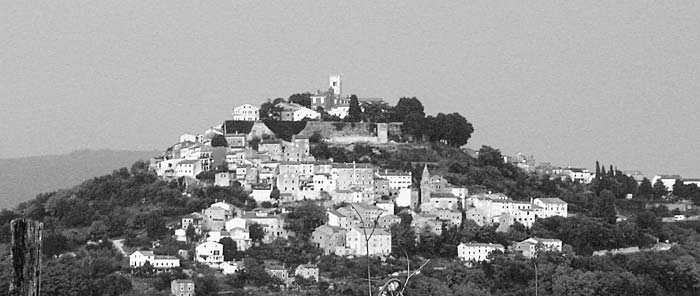
Rovinj • Pula • The Brijuni Islands • Poreč • Hill Towns • Opatija and Rijeka
Hill Towns of the Istrian Interior
Idyllic Istria (EE-stree-ah; “Istra” in Croatian), at Croatia’s northwest corner, reveals itself to you gradually and seductively. Pungent truffles, Roman ruins, striking hill towns, quaint coastal villages, carefully cultivated food and wine, and breezy Italian culture all compete for your attention. The wedge-shaped Istrian Peninsula, while not as famous as its southern rival (the much-hyped Dalmatian Coast), is giving Dalmatia a run for its money.
The Istrian coast, with gentle green slopes instead of the sheer limestone cliffs found along the rest of the Croatian shoreline, is more serene than sensational. It’s lined with pretty, interchangeably tacky resort towns, such as the tourist mecca Poreč (worthwhile only for its mosaic-packed Byzantine basilica). But one seafront village reaches the ranks of greatness: romantically creaky Rovinj, my favorite little town on the Adriatic. Down at the tip of Istria is big, industrial Pula, offering a bustling urban contrast to the rest of the time-passed coastline, plus some impressive Roman ruins (including an amphitheater so remarkably intact, you’ll marvel that you haven’t heard of it before). Just offshore are the Brijuni Islands—once the stomping grounds of Marshal Tito, whose ghost still haunts a national park peppered with unexpected attractions.
But Croatia is more than the sea, and diverse Istria offers some of the country’s most appealing reasons to head inland. In the Istrian interior, between humble concrete towns crying out for a paint job, you’ll find vintners painstakingly reviving a delicate winemaking tradition, farmers pressing that last drop of oil out of their olives, trained dogs sniffing out truffles in primeval forests, and a smattering of fortified medieval hill towns with sweeping views over the surrounding terrain—including the justifiably popular village of Motovun.
Istria offers an exciting variety of attractions compared to the relatively uniform, if beautiful, string of island towns farther south. While some travelers wouldn’t trade a sunny island day for anything, I prefer to sacrifice a little time on the Dalmatian Coast for the diversity that comes with a day or two exploring Istria’s hill towns and other unique sights.
Istria’s main logistical advantage is that it’s easy to reach and to explore by car. Just a quick hop from Venice or Slovenia, compact little Istria is made-to-order for a quick, efficient road trip.
With a car and two weeks to spend in Croatia and Slovenia, Istria deserves two days, divided between its two big attractions: the coastal town of Rovinj and the hill towns of the interior. Ideally, make your home base for two nights in Rovinj or in Motovun, and day-trip to the region’s other attractions. To wring the most out of limited Istrian time, the city of Pula and its Roman amphitheater are well worth a few hours. If you have a car, it’s easy to go for a joyride through the Istrian countryside, visiting a few hill towns and wineries en route. The town of Poreč and the fun but time-consuming Brijuni Islands merit a detour only if you’ve got at least three days.
Istria is a cinch for drivers, who find distances short and roads and attractions well-marked (though summer traffic can be miserable, especially on weekends). Istria is neatly connected by a speedy highway nicknamed the ipsilon (the Croatian word for the letter Y, which is what the highway is shaped like). One branch of the “Y” (A-9) runs roughly parallel to the coast from Slovenia to Pula, about six miles inland; the other branch (A-8) cuts diagonally northeast to the Učka Tunnel (leading to Rijeka). You’ll periodically come to toll booths, where you’ll pay a modest fee for using the ipsilon. Following road signs here is easy (navigate by town names), but if you’ll be driving a lot, pick up a good map to more easily navigate the back roads. As you drive, keep an eye out for characteristic stone igloos called kažun (a symbol of Istria). Formerly used as very humble residences, now the few surviving structures—sometimes built right into a dry-stone wall—are mostly used as shelter for farmers caught in the rain.
If you’re relying on public transportation, Istria can be frustrating: The towns that are easiest to reach (Poreč and Pula) are less appealing than Istria’s highlights (Rovinj and Motovun). Linking up the coastal towns by bus is doable if you’re patient and check schedules carefully, but the hill towns probably aren’t worth the hassle. Even if you’re doing the rest of your trip by public transportation, consider renting a car for a day or two in Istria.
Driving from Istria to Rijeka (and the Rest of Croatia): Istria meets the rest of Croatia at the big port city of Rijeka (described at the end of this chapter). There are two ways to get to Rijeka: The faster alternative is to take the ipsilon road via Pazin to the Učka Tunnel (28-kn toll), which emerges just above Rijeka and Opatija (for Rijeka, you’ll follow the road more or less straight on; for Opatija, you’ll twist down to the right, backtracking slightly to the seashore below you). Or you can take the slower but more scenic coastal road from Pula via Labin. After going inland for about 25 miles, this road jogs to the east coast of Istria, which it hugs all the way into Opatija, then Rijeka.
From Rijeka, you can easily hook into Croatia’s expressway network (for example, take A-6 east to A-1, which zips you north to Zagreb or south to the Dalmatian Coast). For more driving tips, see the end of this chapter.
By Boat to Venice, Piran, or Trieste: Various companies connect Venice daily in summer with Rovinj, Poreč, and Pula (about three hours). While designed for day-trippers from Istria to Venice, these services can be used for one-way travel. As the companies and specific routes change from year to year, check each of these websites to see what might work for your itinerary: Venezia Lines (www.venezialines.com), Adriatic Lines (www.adriatic-lines.com), and Commodore Cruises (www.commodore-cruises.hr). Trieste Lines (www.triestelines.it) connects Rovinj and Poreč to Piran (Slovenia), then Trieste (Italy).
Rising dramatically from the Adriatic as though being pulled up to heaven by its grand bell tower, Rovinj (roh-VEEN; in Italian: Rovigno/roh-VEEN-yoh) is a welcoming Old World oasis in a sea of tourist kitsch. Among the villages of Croatia’s coast, there’s something particularly romantic about Rovinj—the most Italian town in Croatia’s most Italian region. Rovinj’s streets are delightfully twisty, its ancient houses are characteristically crumbling, and its harbor—lively with real-life fishermen—is as salty as they come. Like a little Venice on a hill, Rovinj is the atmospheric setting of your Croatian seaside dreams.
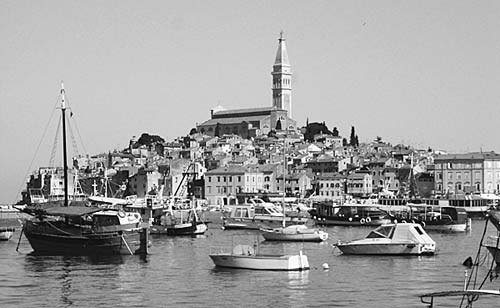
Rovinj was prosperous and well-fortified in the Middle Ages. It boomed in the 16th and 17th centuries, when it was flooded with refugees fleeing both the Ottoman invasions and the plague. Because the town was part of the Republic of Venice for five centuries (13th to 18th centuries), its architecture, culture, and even language are strongly Venetian. The local folk groups sing in a dialect actually considered more Venetian than what the Venetians themselves speak these days. (You can even see Venice from Rovinj’s church bell tower on a very clear day.)
After Napoleon seized the region, then was defeated, Rovinj became part of Austria. The Venetians had neglected Istria, but the Austrians invested in it, bringing the railroad, gas lights, and a huge Ronhill tobacco factory. (This factory—recently replaced by an enormous, state-of-the-art facility you’ll pass on the highway farther inland—is one of the town’s most elegant structures, and is slated for extensive renovation in the coming years.) The Habsburgs tapped Pula and Trieste to be the empire’s major ports—cursing those cities with pollution and sprawl, while allowing Rovinj to linger in its trapped-in-the-past quaintness.
Before long, Austrians discovered Istria as a handy escape for a beach holiday. Tourism came to Rovinj in the late 1890s, when a powerful Austrian baron bought one of the remote, barren islands offshore and brought it back to life with gardens and a grand villa. Before long, another baron bought another island...and a tourist boom was under way. In more recent times, Rovinj has become a top destination for nudists. The resort of Valalta, just to the north, is a popular spot for those seeking “southern exposure”...as a very revealing brochure at the TI illustrates (www.valalta.hr). Whether you want to find PNBs (pudgy nude bodies), or avoid them, remember that the German phrase FKK (Freikörper Kultur, or “free body culture”) is international shorthand for nudism.
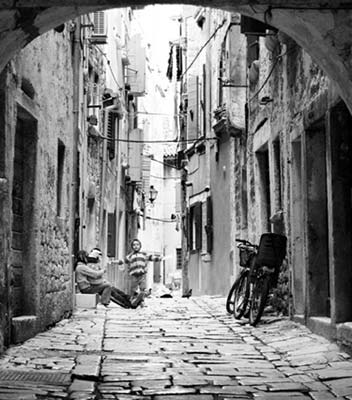
Rovinj is the most atmospheric of all of Croatia’s small coastal towns. Maybe that’s because it’s always been a real town, where poor people lived. You’ll find no fancy old palaces here—just narrow streets lined with skinny houses that have given shelter to humble families for generations. While it’s becoming known on the tourist circuit, Rovinj retains the soul of a fishermen’s village; notice that the harbor is still filled not with glitzy yachts, but with a busy fishing fleet.
Rovinj is hardly packed with diversions. You can get the gist of the town in a one-hour wander. The rest of your time is for enjoying the ambience, savoring a slow meal, or pedaling a rental bike to a nearby beach. When you’re ready to overcome your inertia, there’s no shortage of day trips (the best are outlined in this chapter). Be aware that much of Rovinj (like other small Croatian coastal towns) closes down from mid-October through Easter.
Rovinj, once an island, is now a peninsula. The Old Town is divided in two parts: a particularly charismatic chunk on the oval-shaped peninsula, and the rest on the mainland (with similarly time-worn buildings, but without the commercial cuteness that comes with lots of tourist money). Where the mainland meets the peninsula is a broad, bustling public space called Tito Square (Trg Maršala Tita). The Old Town peninsula—traffic-free except for the occasional moped—is topped by the massive bell tower of the Church of St. Euphemia. At the very tip of the peninsula is a small park.
Rovinj’s TI, facing the harbor, has several handy, free materials, including a town map and an info booklet (June-Sept daily 7:00-22:00; Oct and May daily 8:00-21:00; Nov-April Mon-Fri 8:00-15:00, Sat 8:00-13:00, closed Sun; along the embankment at Obala Pina Budičina 12, tel. 052/811-566, www.tzgrovinj.hr).
By Car: Only local cars are allowed to enter the Old Town area (though if you’re overnighting in this area, they may let you drive in just long enough to drop off your bags—ask your host for details). To get as close as possible—whether you’re staying in the Old Town, or just visiting for the day—use the big waterfront Valdibora parking lots just north of the Old Town, which come with the classic Rovinj view (July-Aug: 6.5 kn/hour, April-June and Sept: 5 kn/hour, Oct-March: 2 kn/hour). As you drive in from the highway through the outskirts of Rovinj, the road forks, sending most hotel traffic to the left (turn off here if you’re staying outside the Old Town); but if you want to reach the Old Town, go right instead, then follow Centar signs, which eventually lead you directly to the two Valdibora lots: “Valdibora 1” (a.k.a. “Big Valdibora,” farther from the Old Town), then “Valdibora 2” (a.k.a. “Little Valdibora,” closer to the Old Town). During busy times, the slightly closer Valdibora 2 is reserved for residents; in this case, signs will divert you into Valdibora 1.
If both Valdibora lots are full, you’ll be pushed to another pay lot farther out, along the bay northwest of the Old Town (a scenic 15-minute walk from town; summer: 5-6 kn/hour, free 23:00-6:00; winter: 2 kn/hour, free 20:00-6:00 and on Sun). Even if the Valdibora lots are available, budget-oriented drivers may prefer this somewhat cheaper outer lot—the cost adds up fast if you’re parking over several nights. Accommodations outside of the Old Town generally have on-site (or nearby streetside) parking, often free; a few places in the Old Town have parking available outside of town.
By Bus: The bus station is on the south side of the Old Town, close to the harbor. Leave the station to the left, then walk on busy Carera street directly into the center of town. Note that there are plans to move the bus station to the other side of the Old Town, just above the long waterfront parking lots. If your bus stops here instead, simply head down to the main road and walk along the parking lots into town.
By Boat: The few boats connecting Rovinj to Venice, Piran, Trieste, and other Istrian towns dock at the long pier protruding from the Old Town peninsula. Just walk up the pier, and you’re in the heart of town.
Internet Access: In public areas (such as the harborfront square), check for a free (if slow) Wi-Fi signal called “Hotspot Croatia.” A-Mar Internet Club has pay Wi-Fi, several terminals, and long hours (36 kn/hour at a terminal, 10 kn/hour for Wi-Fi, daily 9:00-22:00, shorter hours off-season, on the main drag in the mainland part of the Old Town, Carera 26, tel. 052/841-211).
Laundry: The full-service Galax launderette hides up the street beyond the bus station. You can usually pick up your laundry after 24 hours, though same-day service might be possible if you drop it off early enough in the morning (90 kn/load wash and dry; Easter-Sept daily 6:00-20:00, until later in summer; Oct-Easter Mon-Fri 7:00-19:00, Sat 9:00-15:00, closed Sun; up Benussia street past the bus station, on the left after the post office, tel. 052/816-130).
Local Guide: Vukica Palčić is a very capable guide who knows her town intimately and loves to share it with visitors (€50 for a 1.5-hour tour, mobile 098-794-003, vukica.palcic@pu.t-com.hr).
Best Views: The town is full of breathtaking views. Photography buffs will be busy in the magic hours of early morning and evening, and even by moonlight. The postcard view of Rovinj is from the parking lot embankment at the north end of the Old Town (at the start of the “Self-Guided Walk,” next). For a different perspective on the Old Town, head for the far side of the harbor on the opposite (south) end of town. The church bell tower provides an almost aerial view of the town and a grand vista of the outlying islands.
This orientation walk introduces you to Rovinj in about an hour. Begin at the parking lot just north of the Old Town.
Many places offer fine views of Rovinj’s Old Town, but this is the most striking. Boats bob in the harbor, and behind them Venetian-looking homes seem to rise from the deep. (For an aerial perspective, notice the big billboard overhead and to the left.)
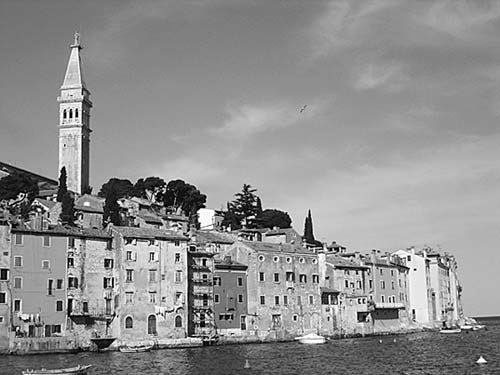
The Old Town is topped by the church, whose bell tower is capped by a weathervane in the shape of Rovinj’s patron saint, Euphemia. Local fishermen look to this saintly weathervane for direction: When Euphemia is looking out to sea, it means the stiff, fresh Bora wind is blowing, bringing dry air from the interior...a sailor’s delight. But if she’s facing the land, the humid Jugo wind will soon bring bad weather from the sea. After a day or so, even a tourist learns to look to St. Euphemia for the weather forecast. (For more on Croatian winds and weather, see the sidebar on here.)
As you soak in this scene, ponder how the town’s history created its current shape. In the Middle Ages, Rovinj was an island, rather than a peninsula, and it was surrounded by a double wall—a protective inner wall and an outer seawall. Because it was so well-defended against pirates and other marauders (and carefully quarantined from the plague), it was extremely desirable real estate. And yet, it was easy to reach from the mainland, allowing it to thrive as a trading town. With more than 10,000 residents at its peak, Rovinj became immensely crowded, which explains today’s pleasantly claustrophobic Old Town.
Over the centuries—as demand for living space trumped security concerns—the town walls were converted into houses, with windows grafted on to their imposing frame. Gaps in the wall, with steps that seem to end at the water, are where fishermen would pull in to unload their catch directly into the warehouses on the bottom level of the houses. (Later you can explore some of these lanes from inside the town.) Today, if you live in one of these houses, the Adriatic is your backyard.
• Now head into town. In the little park near the sea, just beyond the end of the parking lot, look for the big, blocky...
Dating from the time of Tito, this celebrates the Partisan Army’s victory over the Nazis in World War II and commemorates the victims of fascism. The minimalist reliefs on the ceremonial tomb show a slow prisoners’ parade, the victims prodded by a gun in the back from a figure with a Nazi-style helmet. Notice that one side of the monument is in Croatian, and the other is in Italian. With typical Yugoslav grace and subtlety, this jarring block shatters the otherwise harmonious time-warp vibe of Rovinj. Fortunately, it’s the only modern structure anywhere near the Old Town.
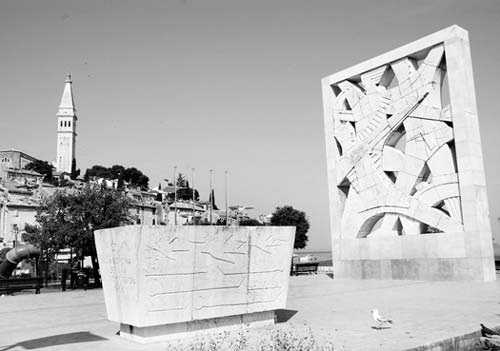
• Now walk a few more steps toward town and past the playground, stopping to explore the covered...
The front part of the market, near the water, is for souvenirs. But natives delve deeper in, to the produce stands. Separating the gifty stuff from the nitty-gritty produce is a line of merchants aggressively pushing free samples. Everything is local and mostly homemade. Consider this snack-time tactic: Loiter around, joking with the farmers while sampling their various tasty walnuts, figs, cherries, grapes, olive oils, honey, rakija (the powerful schnapps popular throughout the Balkans), and more. If the sample is good, buy some more for a picnic. In the center of the market, a delightful and practical fountain from 1908 reminds locals of the infrastructure brought in by their Habsburg rulers a century ago. The hall labeled Ribarnica/Pescheria at the back of the market is where you’ll find fresh, practically wriggling fish. This is where locals gather ingredients for their favorite dish, brodet—a stew of various kinds of seafood mixed with olive oil and wine...all of Istria’s best bits rolled into one dish. It’s slowly simmered and generally served with polenta (unfortunately, it’s rare in restaurants).
• Continue up the broad street, named for Giuseppe Garibaldi—one of the major players in late 19th-century Italian unification. Imagine: Even though you’re in Croatia, Italian patriots are celebrated in this very Italian-feeling town (see the “Italo-Croatia” sidebar). After one long block, on your left, you’ll come to the wide cross-street called...
This marks the site of the medieval bridge that once connected the fortified island of Rovinj to the mainland (as illustrated in the small painting above the door of the Kavana al Ponto—“Bridge Café”). Back then, the island was populated mostly by Italians, while the mainland was the territory of Slavic farmers. But as Rovinj’s strategic importance waned, and its trading status rose, the need for easy access became more important than the canal’s protective purpose—so in 1763, it was filled in. The two populations integrated, creating the bicultural mix that survives today.
Notice the breeze? Via Garibaldi is nicknamed Val di Bora (“Valley of the Bora Wind”) for the constant cooling wind that blows here. On the island side of Trg na Mostu is the Rovinj Heritage Museum (described later, under “Sights in Rovinj”). Next door, the town’s cultural center posts lovingly hand-lettered signs in Croatian and Italian announcing upcoming musical events (generally free, designed for locals, and worth noting and enjoying).
Nearby (just past Kavana al Ponto, on the left), the Viecia Batana Café—named for Rovinj’s unique, flat-bottomed little fishing boats—has a retro interior with a circa-1960 fishermen’s mural that evokes an earlier age. The café is popular for its chocolate cake and “Batana” ice cream.
• Now proceed (passing handwritten signs in Croatian and Italian listing upcoming events) to the little fountain in the middle of the square, facing the harbor.
This wide-open square at the entrance to the Old Town is the crossroads of Rovinj. The fountain, with a little boy holding a water-spouting fish, celebrates the government-funded water system that finally brought running water to the Old Town in 1959. Walk around the fountain, with your eyes on the relief, to see a successful socialist society at the inauguration of this new water system. Despite the happy occasion, the figures are pretty stiff—conformity trumped most other virtues in Tito’s world.
Now walk out to the end of the concrete pier, called the Mali Molo (“Little Pier”). From here, you’re surrounded by Rovinj’s crowded harbor, with fishing vessels and excursion boats that shuttle tourists out to the offshore islands. If the weather’s good, a boat trip can be a fun way to get out on the water for a different angle on Rovinj (see “Activities in Rovinj,” later, for details).
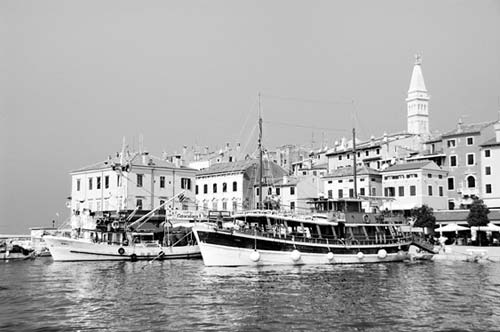
Scan the harbor. On the left is the MMC, the local meeting and concert hall (described later, under “Nightlife in Rovinj”). Above and behind the MMC, the highest bell tower inland marks the Franciscan monastery, which was the only building on the mainland before the island town was connected to shore. Along the waterfront to the right of the MMC is the multicolored Hotel Park, a typical monstrosity from the communist era, now tastefully renovated inside. A recommended bike path starts just past this hotel, leading into a nature preserve and the best nearby beaches (which you can see in the distance; for more on bike rental, see “Activities in Rovinj,” later).
Now head back to the base of the pier. If you were to walk down the embankment between the harbor and the Old Town (past Hotel Adriatic), you’d find the TI, the recommended House of the Batana Boat museum, and a delightful “restaurant row” with several tempting places for a drink or a meal. Many fishermen pull their boats into this harbor, then simply carry their catch across the street to a waiting restaurateur. (This self-guided walk finishes with a stroll down this lane.)
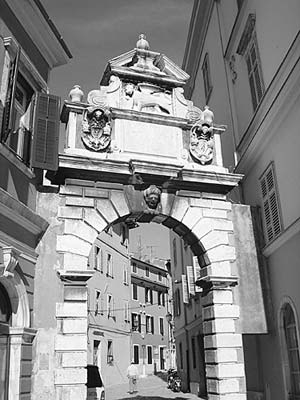
Backtrack 20 paces past the fountain and face the Old Town entrance gate, called the Balbi Arch. The winged lion on top is a reminder that this was Venetian territory for centuries.
• Head through the gate into the Old Town. Inside and on the left is the red...
On the old Town Hall, notice another Venetian lion, as well as other historic crests embedded in the wall. The Town Hall actually sports an Italian flag (along with ones for Rovinj, Croatia, and the EU) and faces a square named for Giacomo Matteotti, a much-revered Italian patriot.
Continue a few more steps into town. Gostionica/Trattoria Cisterna faces another little square, which once functioned as a cistern (collecting rainwater, which was pulled from a subterranean reservoir through the well you see today). The building on your left is the Italian Union—yet another reminder of how Istria has an important bond with Italy.
• Now begin walking up the street to the left of Gostionica/Trattoria Cisterna. Passing the recommended Piassa Granda wine bar on your left, veer right up...
The main “street” (actually a tight lane) leading through the middle of the island is choked with tourists during the midday rush and lined with art galleries. This inspiring town has attracted many artists, some of whom display their works along this colorful stretch. Notice the rusty little nails speckling the walls—each year in August, an art festival invites locals to hang their best art on this street. With paintings lining the lane, the entire community comes out to enjoy each other’s creations.
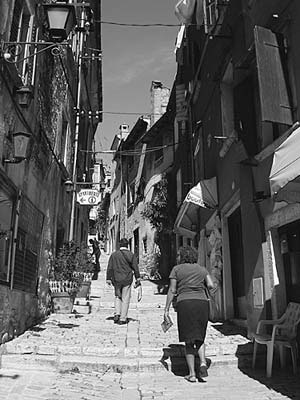
As you walk, keep your camera ready, as you can find delightful scenes down every side lane. Remember that, as crowded as it is today, little Rovinj was even more packed in the Middle Ages. Keep an eye out for arches that span narrow lanes (such as on the right, at Arsenale street)—the only way a walled city could grow was up. Many of these additions created hidden little courtyards, nooks, and crannies that make it easy to get away from the crowds and claim a corner of the town for yourself. Another sign of Rovinj’s overcrowding are the distinctive chimneys poking up above the rooftops. These chimneys, added long after the buildings were first constructed, made it possible to heat previously underutilized rooms...and squeeze in even more people.
• Continue up to the top of Grisia. Capping the town is the can’t-miss-it...
Rovinj’s landmark Baroque church dates from 1754. It’s watched over by an enormous 190-foot-tall campanile, a replica of the famous bell tower on St. Mark’s Square in Venice. The tower is topped by a copper weathervane with the weather-predicting St. Euphemia, the church’s namesake.
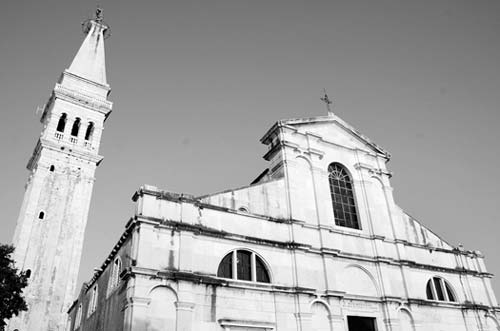
Cost and Hours: Free, generally open May-Sept daily 10:00-18:00, Easter-April and Oct-Nov open only for Mass and with demand, generally closed Dec-Easter.
Visiting the Church: The vast, somewhat gloomy interior boasts some fine altars of Carrara marble (a favorite medium of Michelangelo’s). Services here are celebrated using a combination of Croatian and Italian, suiting the town’s mixed population.
To the right of the main altar is the church’s highlight: the chapel containing the relics of St. Euphemia. Before stepping into the chapel, notice the altar featuring Euphemia—depicted, as she usually is, with her wheel (a reminder of her torture) and a palm frond (symbolic of her martyrdom), and holding the fortified town of Rovinj, of which she is the protector.
Now head into the little chapel behind the altar. In the center is a gigantic tomb, and on the walls above are large paintings that illustrate two significant events from the life of this important local figure. St. Euphemia was the virtuous daughter of a prosperous early fourth-century family in Chalcedon (near today’s Istanbul). Euphemia used her family’s considerable wealth to help the poor. Unfortunately, her pious philanthropy happened to coincide with anti-Christian purges by the Roman Emperor Diocletian. When she was 15 years old, Euphemia was arrested for refusing to worship the local pagan idol. She was brutally tortured, her bones broken on a wheel. Finally she was thrown to the lions as a public spectacle. But, the story goes, the lions miraculously refused to attack her. You can see this moment depicted in one of the paintings above—as a bored-looking lion tenderly nibbles at her right bicep.
Flash forward to the year 800, when a gigantic marble sarcophagus containing St. Euphemia’s relics somehow found its way into the Adriatic and floated all the way up to Istria, where Rovinj fishermen discovered it bobbing in the sea. They tugged it back to town, where a crowd gathered. The townspeople realized what it was and wanted to take it up to the hilltop church. But nobody could move it...until a young boy with two young calves showed up. He said he’d had a dream of St. Euphemia—and, sure enough, he succeeded in dragging her relics to where they still lie. In the painting above, see the burly fishermen looking astonished as the boy succeeds in moving the giant sarcophagus. Note the depiction of Rovinj fortified by a double crenellated wall—looking more like a castle than like the creaky fishing village of today. At the top of the hill is an earlier version of today’s church.
Now turn your attention to Euphemia’s famous sarcophagus. The front panel (with the painting of Euphemia) is opened with much fanfare every September 16, St. Euphemia’s feast day, to display the small, withered, waxen face of Rovinj’s favorite saint.
• If you have time and energy, consider climbing the...
Scaling the church bell tower’s creaky wooden stairway requires an enduring faith in the reliability of wood. It rewards those who brave its 192 stairs with a commanding view of the town and surrounding islands. The climb doubles your altitude, and from this perch you can also look down—taking advantage of the quirky little round hole in the floor to photograph the memorable staircase you just climbed.
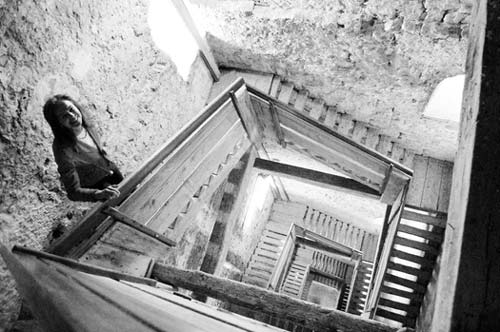
Cost and Hours: 15 kn, same hours as church, enter from inside church—to the left of the main altar.
• Leave the church through the main door. A peaceful café on a park terrace (once a cemetery) is just ahead and below you. Just to the right, a winding, cobbled lane leads past the café entrance and down toward the water, then forks. A left turn here zigzags you past a WWII pillbox and leads along the “restaurant row,” where you can survey your options for a drink or a meal (see “Eating in Rovinj,” later). A right turn curls you down along the quieter northern side of the Old Town peninsula. Either way, Rovinj is yours to enjoy.
Rovinj has a long, noble shipbuilding tradition, and this tiny but interesting museum gives you the story of the town’s distinctive batana boats. Locals say this museum puts you in touch with the soul of Rovinj.
The flat-bottomed vessels are favored by local fishermen for their ability to reach rocky areas close to shore that are rich with certain shellfish. The museum explains how the boats are built, with the help of an entertaining time-lapse video showing a boat built from scratch in five minutes. You’ll also meet some of the salty old sailors who use these vessels (find the placemat with wine stains, and put the glass in different red circles to hear various seamen talk in the Rovinj dialect). Another movie shows the boats at work. Upstairs is a wall of photos of batana boats still in active use, a tiny library (peruse photos of the town from a century ago), and a video screen displaying bitinada music—local music with harmonizing voices that imitate instruments. Sit down and listen to several (there’s a button for skipping ahead). The museum has no posted English information, so pick up the comprehensive English flier as you enter.
Cost and Hours: 10 kn; June-Sept daily 10:00-14:00 & 19:00-23:00; Oct-Dec and March-May Tue-Sun 10:00-13:00 & generally also 16:00-18:00, closed Mon; closed Jan-Feb; Obala Pina Budicina 2, tel. 052/812-593, mobile 091-154-6598, www.batana.org, Ornela.
Activities: The museum, which serves as a sort of cultural heritage center for the town, also presents a variety of engaging batana-related activities. On some summer evenings, you can take a boat trip on a batana from the pier near the museum. The trip, which is accompanied by traditional music, circles around the end of the Old Town peninsula and docks on the far side, where a traditional wine cellar has a fresh fish dinner ready, with local wine and more live music (June-mid-Sept, generally Tue and Thu at 20:30, boat trip-60 kn, dinner-160 kn extra, visit or call the museum the day before to reserve). Also on some summer evenings, you can enjoy an outdoor food market with traditional Rovinj foods and live bitinada music. The centerpiece is a batana boat being refurbished before your eyes (in front of museum, 20-30-kn light food, mid-June-early Sept generally Tue and Sat 20:00-23:00). Even if you’re here off-season, ask at the museum if anything special is planned.
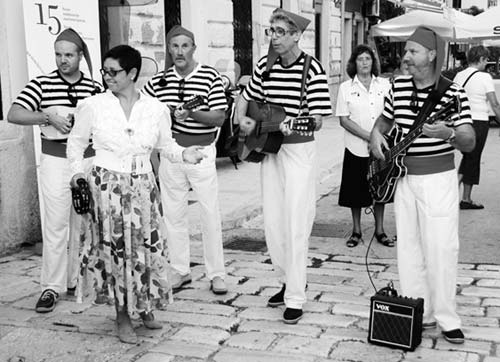
This ho-hum museum combines art old (obscure classic painters) and new (obscure contemporary painters from Rovinj) in an old mansion. Rounding out the collection are some model ships, a small archaeological exhibit, and temporary exhibits.
Cost and Hours: 15 kn; mid-June-mid-Sept Tue-Fri 10:00-14:00 & 18:00-22:00, Sat-Sun 10:00-14:00 & 19:00-22:00, closed Mon; off-season Tue-Sat 10:00-13:00, closed Sun-Mon; Trg Maršala Tita 11, tel. 052/816-720, www.muzej-rovinj.com.
This century-old collection of local sea life is one of Europe’s oldest aquariums. Unfortunately, it’s also tiny (with three sparse rooms holding a few tanks of what you’d see if you snorkeled here), disappointing, and overpriced.
Cost and Hours: 30 kn, daily June-Aug 9:00-21:00, Sept 9:00-20:00, Oct-May 10:00-16:00 or longer depending on demand, across the street from the end of the waterfront parking lot at Obala G. Paliage 5, tel. 052/804-712.
For a different view of Rovinj, consider a boat trip. The scenery is pleasant rather than thrilling, but the craggy and tree-lined coastline and offshore islets are a lovely backdrop for an hour or two at sea. You’ll see captains hawking boat excursions at little shacks all along Rovinj’s harbor. The most common option is a 1.5-hour loop around the “Golden Cape” (Zlatni Rt) and through Rovinj’s own little archipelago for about 75 kn; this is most popular at sunset. For a longer cruise, consider the four-hour, 150-kn sail north along the coast and into the underwhelming Limski Canal (a.k.a. “Limski Fjord”), where you’ll have one to two hours of free time. Dolphin sightings are not unusual, and some outfits throw in a “fish picnic” en route for extra. Stroll the harbor and comparison-shop to find the option that suits your interest.
You can also take a boat to one of the larger offshore islands. This lets you get away from the crowds and explore some relatively untrampled beaches. These boats—run by the big hotel chain with branches on those islands—depart about hourly from the end of the concrete pier in the Old Town known as the Mali Molo (“Little Pier”). The two choices are St. Catherine (Sv. Katarina—the lush, green island just across the harbor, about a 5-minute trip, 25 kn) and Red Island (Crveni Otok—farther out, about a 15-minute trip, boats may be marked “Hotel Istra,” 40 kn).
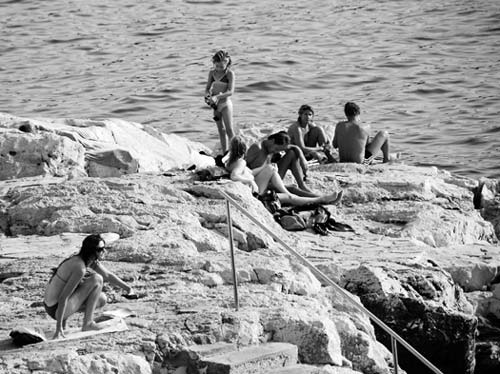
Rovinj doesn’t have any sandy beaches—just rocky ones. (The nearest thing to a sandy beach is the small, finely pebbled beach on Red Island/Crveni Otok.) The most central spot to swim or sunbathe is at Balota Beach, on the rocks along the embankment on the south side of the Old Town peninsula, just past La Puntuleina restaurant (no showers, but scenic and central). On nice days, Balota can get crowded; if you continue around Rovinj’s peninsula to the tip, just before the old WWII pillbox you’ll find the more secluded “Pillbox Beach,” where steps lead steeply down to a cluster of more secluded rocks. For bigger beaches, go to the wooded Golden Cape (Zlatni Rt) south of the harbor (past the big, waterfront Hotel Park). This cape is lined with walking paths and beaches, and shaded by a wide variety of trees and plants. For a scenic sunbathing spot, choose a perch facing Rovinj on the north side of the Golden Cape. Another beach, called Kuvi, is beyond the Golden Cape. To get away from it all, take a boat to an island on Rovinj’s little archipelago (see previous listing).
The TI’s free, handy biking map suggests a variety of short and long bike rides. The easiest and most scenic is a quick loop around the Golden Cape (Zlatni Rt, described above). You can do this circuit and return to the Old Town in about an hour (without stops). Start by biking south around the harbor and past the waterfront Hotel Park, where you leave the cars and enter the wooded Golden Cape. Peaceful miniature beaches abound. The lane climbs to a quarry (much of Venice was paved with Istrian stone), where you’re likely to see beginning rock climbers inching their way up and down. Cycling downhill from the quarry and circling the peninsula, you hit the Lovor Grill (open daily in summer 10:00-16:00 for drinks and light meals)—a cute little restaurant housed in the former stables of the Austrian countess who planted what today is called “Wood Park.” From there, you can continue farther along the coast or return to town (backtrack two minutes and take the right fork through the woods back to the waterfront path).
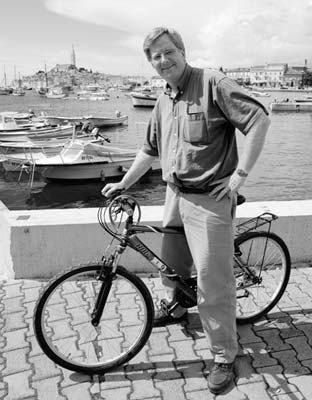
For a more ambitious, inland pedal, pick up the TI’s free Basìlica bike map, which narrates a 12-mile loop that connects several old churches.
Bike Rental: Bikes are rented at subsidized prices from the city parking lot kiosk (5 kn/hour, open 24 hours daily except no rentals in winter, fast and easy process; choose a bike with enough air in its tires or have them pumped up, as the path is rocky and gravelly). Various travel agencies around town rent bikes for much more (around 20 kn/hour); look for signs—especially near the bus station—or ask around.
Rovinj is a delight after dark. Views that are great by day become magical in the moonlight and floodlight. The streets of the Old Town are particularly inviting when empty and starlit.
Lots of low-key, small-time music events take place right in town (ask at the TI, check the events calendar at www.tzgrovinj.hr, and look for handwritten signs in Croatian and Italian on Garibaldi Street near the Square at the Bridge). Groups perform at various venues around town: right along the harborfront (you’ll see the bandstand set up); in the town’s churches (especially St. Euphemia and the Franciscan church); in the old cinema/theater by the market; at the pier in front of the House of the Batana Boat (described earlier, under “Sights in Rovinj”); and at the Multi-Media Center (a.k.a. the “MMC,” which locals call “Cinema Belgrade”—its former name), in a cute little hall above a bank across the harbor from the Old Town.
Rovinj has two good places to sample Istrian and Croatian wines, along with light, basic food—such as prosciutto-like pršut, truffles, and olive oil. Remember, two popular local wines worth trying are malvazija (a light white) and teran (a heavy red). At Bacchus Wine Bar, owner Paolo serves about 80 percent Istrian wines, with the rest from elsewhere in Croatia and international vintners (15-60 kn/deciliter, most around 20-30 kn, 65-250-kn bottles, daily 7:00-1:00 in the morning, shorter hours off-season, Carera 5, tel. 052/812-154). Piassa Granda, on a charming little square right in the heart of the Old Town, has a classy, cozy interior and more than 100 types of wine (25-35-kn glasses, 40-70-kn Istrian small plates, more food than Bacchus, daily 10:00-16:00 & 18:00-24:00, Veli trg 1, mobile 098-824-322, Helena).
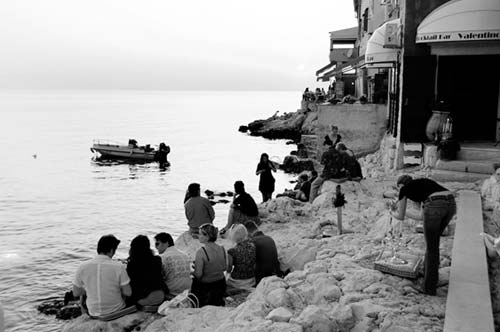
Valentino Champagne and Cocktail Bar is a romantic, justifiably pretentious place for an expensive late-night waterfront drink. Fish, attracted by its underwater lights, swim by from all over the bay...to the enjoyment of those nursing a cocktail on the rocks (literally—you’ll be given a small seat cushion to plunk down in your own seaside niche). Or you can choose to sit on one of the terraces. Classy candelabras twinkle in the twilight, as couples cozy up to each other and the view. While the drinks are extremely pricey, this place is unforgettably cool (60-75-kn cocktails, 60-kn non-alcoholic drinks, daily April-May 12:00-24:00, June-Sept 18:00-24:00, closed Oct-March, Via Santa Croce 28, tel. 052/830-683, Patricia).
If Valentino is too pricey, too chichi, or too crowded for your tastes, a couple of alternatives are nearby. The Monte Carlo bar, along the same drag but a bit closer to the harbor, is fun-loving and serves much cheaper drinks (25-30 kn), but lacks the atmospheric “on the rocks” setting of Valentino (daily 8:00-late, closed Oct-Easter, mobile 091-579-1813). Or consider La Puntuleina, beyond Valentino, with a similarly rocky ambience but lower prices (20-40-kn drinks) and a bit less panache (listed later, under “Eating in Rovinj”). I’d scout all three and pick the ambience you prefer.
In summer, the House of the Batana Boat often hosts special events such as a boat trip and traditional dinner, and an outdoor food court. For details, see the listing earlier, under “Sights in Rovinj.”
As throughout Croatia, most Rovinj accommodations (both hotels and sobe) prefer multinight stays—especially in peak season (July-Aug). While a few places levy surcharges for shorter stays, many are fine with even one-night stays (I’ve noted this in each listing). Don’t show up here without a room in August: Popular Rovinj is packed during that peak month.
All of these accommodations (with one exception) are on the Old Town peninsula, rather than the mainland section of the Old Town. Residence Dream is just around the atmospheric harbor, an easy five-minute walk away. Rovinj has no real hostel, but sobe are a good budget option.
$$$ Villa Markiz, run by Andrej with the help of eager-to-please Ivana, has four extremely mod, stylish apartments in an old shell in the heart of the Old Town. You’ll climb a steep and narrow staircase to reach the apartments, each of which has a small terrace (Db-€130/€80-100/€60). Only the gorgeous top-floor, two-story penthouse apartment has sea views (€250/€150-180/€140; no breakfast, air-con, free Wi-Fi, Pod Lukovima 1, tel. 052/841-380, Ivana mobile 099-652-7660, Andrej mobile 098-934-0321, dani7cro@msn.com).
$$$ Porta Antica rents 16 comfortable, nicely decorated apartments in five different buildings around the Old Town (all except La Carera are on the peninsula). Review your options on their website and be specific in your request (Db-€110-200/€90-170/€80-120, price depends on size and views, extra person-€25, no extra charge for 1-night stays, no breakfast, air-con, non-smoking, free Wi-Fi, reception and main building next door to TI on Obala Pina Budičina, mobile 099-680-1101, www.portaantica.com, portaantica@yahoo.it, Claudia).
$$$ Hotel Adriatic, a lightly renovated holdover from the communist days, features 27 rooms overlooking the main square, where the Old Town peninsula meets the mainland. The quality of the drab, worn rooms doesn’t justify the outrageously high prices...but the location might. Of the big chain of Maistra hotels (described on here), this is the only one in the Old Town (rates flex with demand, in top season figure Sb-€150, Db-€225; these prices are per night for 1- or 2-night stays—cheaper for 3 nights or more, all Sb are non-view, most Db have views—otherwise €20 less, no elevator, air-con, pay Wi-Fi, some nighttime noise—especially on weekends, Trg Maršala Tita, tel. 052/803-510, www.maistra.hr, adriatic@maistra.hr).
$$ Villa Cissa, run by Zagreb transplant Veljko Despot, has three apartments with tastefully modern, artistic decor above an art gallery in the Old Town. Kind, welcoming Veljko—who looks a bit like Robin Williams—is a fascinating guy who had an illustrious career as a rock-and-roll journalist (he was the only Eastern Bloc reporter to interview the Beatles) and record-company executive. Now his sophisticated, artistic style is reflected in these comfortable apartments. Because the place is designed for longer stays, you’ll pay a premium for a short visit (50 percent extra for 2-night stays, prices double for 1-night stays), and it comes with some one-time fees, such as for cleaning. But it’s worth the added expense. Veljko lives off-site, so be sure to clearly communicate your arrival time (smaller apartment-€108/€98/€88 plus €30 one-time cleaning fee, bigger apartment-€110 more plus €50 one-time cleaning fee, extra person-20 percent more, cash only, air-con, free Wi-Fi, lively café across the street, Zdenac 14, tel. 052/813-080, www.villacissa.com, info@villacissa.com).
$$ Casa Garzotto is an appealing mid-range option, with four apartments, four rooms, and one large family apartment in three different Old Town buildings. These classy and classic lodgings have modern facilities but old-fashioned charm, with antique furniture and historic family portraits on the walls. Thoughtfully run by a friendly staff, it’s a winner (rooms—Sb-€80/€80/€70, Db-€120/€105/€90; apartments—Db-€165/€140/€120; 2-bedroom family apartment—Db-€175/€150/€120, extra person-€25-30; includes breakfast, off-site parking, loaner bikes, and other thoughtful extras; 30 percent extra for 1-night stays, air-con, lots of stairs, free Wi-Fi in main building, reception and most apartments are at Garzotto 8, others are a short walk away, tel. 052/811-884, mobile 099-800-7338, www.casa-garzotto.com, casagarzotto@gmail.com).
$$ Trevisol Apartments has four new, modern units on a sleepy Old Town street, plus a few others around town. Check your options on their website, reserve your apartment, and arrange a time to meet (Db-€90/€75/€50; bigger seaview Db-€110/€80/€60; extra charge for 1-night stays: 50 percent in peak season, 30 percent off-season; no breakfast, air-con, free Wi-Fi, Trevisol 40, main office at Sv. Križa 33, mobile 098-177-7404, www.lvi.hr, Adriano).
$$ B&B Casale has three simple but affordable and nicely appointed rooms atmospherically located in a tight lane in the heart of the Old Town. As there’s no air-conditioning, thin windows, and lots of outdoor cafés nearby, it can be noisy at night (Db-€80/€55/€46, breakfast-€9/person, cash only, free Wi-Fi, Casale 2, tel. 052/814-828, mobile 099-888-5947, adr.cer@gmail.com, Adriano).
$$ Residence Dream, tucked in a tight warren of lanes in the touristy restaurant ghetto just around the harbor from the Old Town peninsula, has three modern, pleasantly furnished rooms above a busy restaurant. While you’re not right in the heart of the Old Town, it’s close enough, and it’s worth considering if other mid-range places are full (Db-€85/€75/€60, extra bed-€15, breakfast-60 kn, air-con, free Wi-Fi, good windows but may have some restaurant noise, Rakovca 18, tel. 052/830-613, mobile 091-579-9239, www.dream.hr, dream@dream.hr).
To escape the high prices of Rovinj’s Old Town, consider the resort neighborhood just south of the harbor. These are a 10- to 20-minute walk from the Old Town (in most cases, at least partly uphill), but most of that walk is along the very scenic harborfront—hardly an unpleasant commute. While the big Maistra hotels are an option, I prefer cheaper alternatives in the same area. Given the cost and inconvenience of parking if you’re sleeping in the Old Town (see “Arrival in Rovinj,” earlier, for details), accommodations in this area are handy for drivers. The big hotels are signposted as you approach town (follow signs for hoteli, then your specific hotel). Once you’re on the road to Hotels Eden and Park, the smaller ones are easy to reach: Villa Baron Gautsch is right on the road to Hotel Park; Hotel Vila Lili and Vila Kristina are a little farther on the main road toward Eden (to the left just after turnoff for Hotel Park, look for signs).
These are a bit closer to the Old Town than the Maistra hotels, and offer much lower rates and more personality. The first three are hotelesque and sit up on the hill behind the big resort hotels, while the last two choices lack personality but are a great budget option relatively close to the Old Town (an easy and scenic 10-minute walk).
$$ Villa Baron Gautsch, named for a shipwreck, is a German-owned pension with 17 bright, crisp, comfortable rooms and an inviting, shared view terrace (Db-€80/€70/€60, €10 more for balcony, they also have two Sb for half the Db price, no extra charge for 1-night stays, closed late Oct-Easter, cash only, air-con, no elevator, free Wi-Fi, free street parking, Ronjgova 7, tel. 052/840-538, www.baron-gautsch.com, baron.gautsch@gmx.net, Sanja).
$$ Hotel Vila Lili is a family-run hotel with 20 nicely decorated but slightly faded rooms above a restaurant on a quiet lane. While the rooms are pricey, the extra cost buys you more hotel amenities than the cheaper guest houses listed here (Sb-€65/€55, Db-€110/€100, pricier suites also available, no extra charge for 1-night stays, includes breakfast, elevator, air-con, free Wi-Fi, parking-35 kn/day, Mohorovičića 16, tel. 052/840-940, www.hotel-vilalili.hr, info@hotel-vilalili.hr, Petričević family).
$$ Vila Kristina, run by Kristina Kiš and her family, has 10 rooms and five apartments along a busy road. All but one of the units has a balcony. I’d skip the overpriced apartments (Db-€95/€85, apartment Db-€140/€120, no extra charge for 1-night stays, includes breakfast, air-con, no elevator, free Wi-Fi, Luje Adamovića 16, tel. 052/815-537, www.kis-rovinj.com, kristinakis@mail.inet.hr).
$ Elda Markulin, whose son runs the Baccus Wine Bar, rents three rooms and four apartments in a new, modern house a short walk up from the main harborfront road (Db-€50/€45/€40, apartment-€75/€60/€50, cash only, air-con, free Wi-Fi, Mate Balote 12, tel. 052/811-018, mobile 095-900-8654, markulin@hi.t-com.hr). To reach it from the Old Town, walk along the waterfront; after you pass the recommended Maestral restaurant and the ragtag boatyard on your right, turn left onto the uphill Mate Balote (just before the park).
$ Apartmani Tomo, next door to Elda (see directions above), is run with Albanian pride by Tomo Lleshdedaj, who rents seven rooms and nine studio apartments. While the lodgings are basic and communication can be a bit challenging, it’s a handy location for a budget last resort (Db-€50/€40/€35, Db with kitchen-€70/€60/€50, smaller studio Db-€75/€65/€55, bigger studio Db-€85/€75/€65, extra person-€10, cash only, air-con, free Wi-Fi, Mate Balote 10, tel. 052/813-457, mobile 091-578-1518, no email—reserve by phone).
The local hotel conglomerate, Maistra, has several hotels in the lush parklands just south of the Old Town. As all of the hotels were recently either completely renovated or built from scratch, these are a very expensive option; most of my readers—looking for proximity to the Old Town rather than hanging out at a fancy hotel—will prefer to save money and stay at one of my other listings. However, the Maistra hotels are worth considering if you can get a deal. These hotels have extremely slippery pricing, based on the type of room, the season, and how far ahead you book. (I’ve listed the starting rate for a 1- or 2-night stay in July-Aug; you’ll pay less if you stay longer or visit off-season. Complete rates are explained on the website, www.maistra.hr.) I’ve listed the hotels in the order you’ll reach them as you approach from the Old Town. All hotels have air-conditioning, elevators, free parking, and pay Wi-Fi, and include breakfast in their rates. The Maistra chain also has several other properties (including the Old Town’s Hotel Adriatic, described earlier; Hotel Katarina, a cheaper option with basic rooms picturesquely set on the small island facing the Old Town; and other more distant, cheaper options). Most Maistra hotels close during the winter.
$$$ Hotel Park is the humblest of the pack, with just three stars. It has 202 renovated but dull rooms in a colorized communist-era hull, and a seaside swimming pool with sweeping views to the Old Town. This is the handiest for walking into the Old Town—it’s a 10-minute stroll, entirely along the stunning harborfront promenade (Sb-€144, Db-€180, about €50 more for sea view, tel. 052/808-000, park@maistra.hr).
$$$ Hotel Monte Mulini is the fanciest of the bunch, with five stars, 99 rooms and 14 suites (all with seaview balconies), a beautiful atrium with a huge glass wall overlooking the cove, an infinity pool, and over-the-top prices (Db-€585, tel. 052/636-000, www.montemulinihotel.com, montemulini@maistra.hr).
$$$ Hotel Lone (LOH-neh), named for the cove it overlooks, is the newest and by far the most striking in the collection—the soaring atrium of this “design hotel” feels like a modern art museum. Also extremely expensive, its 248 rooms come wrapped in a vivid package (Db-€350, tel. 052/632-000, www.lonehotel.com, lone@maistra.hr).
$$$ Hotel Eden offers four stars and 325 upscale, imaginatively updated rooms with oodles of contemporary style behind a brooding communist facade (rates about €30 more than Hotel Park, tel. 052/800-400, eden@maistra.hr).
It’s expensive to dine in Rovinj, but the food is generally good, with a few truffle dishes on most menus (see “Istrian Food and Wine” sidebar on here). Interchangeable restaurants cluster where Rovinj’s Old Town peninsula meets the mainland, and all around the harbor. Be warned that most eateries—like much of Rovinj—close for the winter (roughly mid-Oct to Easter). If you’re day-tripping into the Istrian interior, consider dining at one of the excellent restaurants in or near Motovun (see here), then returning to Rovinj after dark.
(See “Rovinj” map, here.)
The easiest dining option is to stroll the Old Town embankment overlooking the harbor (Obala Pina Budičina), which changes its name to Svetoga Križa and cuts behind the buildings after a few blocks. Window-shop the pricey but scenic eateries along here, each of which has its own personality (all open long hours daily). Some have sea views, others are set back on charming squares, and still others have atmospheric interiors. I’ve listed these in the order you’ll reach them. You’ll pay top dollar, but the ambience is memorable.
Scuba, at the start of the row, is closest to the harbor—so, they claim, they get first pick of the daily catch from arriving fishing boats. They serve both seafood and tasty Italian dishes, in a contemporary interior or at outdoor tables with harbor views (70-80-kn pastas, 60-150-kn main dishes, daily 11:00-24:00, Obala Pina Budičina 6, mobile 098-219-446).
Veli Jože, with a smattering of outdoor tables (no real views) and a rollicking, folksy interior decorated to the hilt, is in all the guidebooks but still delivers on its tasty, traditional Istrian cuisine (50-80-kn pastas, 45-55-kn basic grill dishes, 110-160-kn main courses, daily 11:00-24:00, Sv. Križa 1, tel. 052/816-337).
Santa Croce, with tables scenically scattered along a terraced incline that looks like a stage set, is well-respected for its seafood and pastas. Classy and sedate, and with attentive service, it attracts a slightly older clientele (45-60-kn pastas, 70-150-kn main courses, no sea views, daily 18:00-23:00, Sv. Križa 11, tel. 052/842-240).
Lampo is simpler, with a basic menu of salads, pizzas, and pastas. The only reason to come here is for the fine waterfront seating at a reasonable price (45-65-kn pastas, 60-120-kn main courses, daily 11:00-24:00, Sv. Križa 22, tel. 052/811-186).
La Puntuleina, at the end of the row, is the most scenic (and most expensive) option. This upscale restaurant/wine bar features Istrian, Italian, and Mediterranean cuisine served in the contemporary dining room, or outside—either on one of the many terraces, or at tables scattered along the rocks overlooking a swimming hole. The menu is short, and Miriam and Giovanni occasionally add seasonal specials. As the outdoor seating is deservedly popular, reserve ahead (10-kn cover charge, 80-110-kn pastas, 120-180-kn main courses, daily 12:00-23:00, closed Nov-Easter, on the Old Town embankment past the harbor at Sv. Križa 38, tel. 052/813-186). You can also order just a drink to sip while sitting down on the rocks.
Just before La Puntuleina, don’t miss the inviting Valentino Champagne and Cocktail Bar—with no food but similar “drinks on the rocks” ambience (described earlier, under “Nightlife in Rovinj”). If you’re on a tight budget, dine cheaply elsewhere, then come here for an after-dinner finale.
(See “Rovinj” map, here.)
Offering upscale, international (rather than strictly Croatian) food and presentation, these options are expensive but creative.
Monte Restaurant is your upscale, white-tablecloth splurge—made to order for a fine dinner out. With tables strewn around a covered terrace just under the town bell tower, this atmospheric place features inventive cuisine that melds Istrian products with international techniques. Come here only if you value a fine dining experience, polished service, and the chance to learn about local food and wines without regard for price (plan to spend 350-700 kn per person for dinner, daily 12:00-14:30 & 18:30-23:00, reserve ahead in peak season, Montalbano 75, tel. 052/830-203, Ðekić family).
Krčma Ulika, a classy hole-in-the-wall run by Inja Tucman, has a mellow, cozy, art-strewn interior. Inja enjoys surprising diners with unexpected flavor combinations. The food is a bit overpriced and can be hit-or-miss, but the experience feels like an innovative break from traditional Croatian fare. As portions are small (Inja encourages diners to order two courses), the price can add up (15-kn cover, 80-100-kn starters and pastas, 180-200-kn main courses, daily 13:00-15:00 & 19:00-24:00—except closed for lunch in Aug, closed mid-Oct-April, cash only, Porečka 6, tel. 052/818-089, mobile 098-929-7541).
(See “Rovinj” map, here.)
These options are a bit less expensive than most of those described above. I’ve listed them in the order you’ll reach them as you walk around Rovinj’s harbor.
Maestral combines affordable, straightforward pizzas and seafood with Rovinj’s best view. If you want an outdoor table overlooking bobbing boats and the Old Town’s skyline—without breaking the bank—this is the place. It fills a big building surrounded by workaday shipyards about a 10-minute walk from the Old Town, around the harbor toward Hotel Park (35-45-kn sandwiches, 45-60-kn pizzas and pastas, 50-100-kn fish and meat dishes, daily 9:00-24:00, closed Oct-March, obala N. Nazora b.b., look for Bavaria beer sign, tel. 052/830-565).
Sidro, around the harbor with views back on the Old Town, has a typical menu of pasta, pizza, and fish. But it’s particularly well-respected for its Balkan meat dishes such as ćevapčići (see the “Balkan Flavors” sidebar on here) and a spicy pork-and-onion stew called mućkalica. With unusually polite service and a long tradition (run by three generations of the Paoletti family since 1966), it’s a popular local hangout (45-75-kn pastas, 55-90-kn grilled meat dishes, 110-140-kn steaks and fish, daily 11:00-23:00, closed Nov-Feb, harborfront at Rismondo 14, tel. 052/813-471).
Gostionica/Trattoria Toni is a hole-in-the-wall serving up small portions of good Istrian and Venetian fare. Choose between the cozy interior (tucked down a tight lane), or the terrace on a bustling, mostly pedestrian street (40-95-kn pastas, 40-140-kn main courses, daily 12:00-15:00 & 18:00-22:30, just up ulica Driovier on the right, tel. 052/815-303).
(See “Rovinj” map, here.)
Most rental apartments come with a kitchenette handy for breakfasts (stock up at a neighborhood grocery shop). Cafés and bars along the waterfront serve little more than an expensive croissant with coffee. The best budget breakfast (and a fun experience) is a picnic. Within a block of the market, you have all the necessary stops: the Brionka bakery (fresh-baked cheese or apple strudel); mini-grocery stores (juice, milk, drinkable yogurt, and so on); market stalls (cherries, strawberries, walnuts, and more, as well as an elegant fountain for washing); an Albanian-run bread kiosk, Pekarna Laste, between the market and the water...plus benches with birds chirping, children playing, and fine Old Town views along the water. For a no-fuss alternative, you can shell out 60 kn for the buffet breakfast at Hotel Adriatic (daily 7:00-10:00, until 11:00 July-Aug; described earlier, under “Sleeping in Rovinj”).
Rovinj’s bus station is open daily 6:30-9:15 & 9:45-16:30 & 17:00-21:30. As always, confirm the following times before planning your trip. Bus schedules are dramatically reduced on Saturdays and especially on Sundays, as well as (in some cases) off-season. Bus information: Tel. 060-333-111 or 052/811-453, www.autobusni-kolodvor.com.
From Rovinj by Bus to: Pula (about hourly, 45 minutes), Poreč (3-6/day, 1 hour), Rijeka (4-5/day, 2-3.5 hours), Zagreb (6-9/day, 3-6 hours), Venice (1/day Mon-Sat departing very early in the morning—likely at 5:40, arriving Venice at 10:00, none Sun).
To Slovenia: In the summer, two daily buses connect Rovinj to Slovenia (Piran and Ljubljana): a slow one departing at 8:00 (3 hours to Piran, 5.5 hours to Ljubljana, late June-Aug only) or an express one departing at around 16:35 (2 hours to Piran, 4 hours to Ljubljana, July-Sept only); as this connection changes from year to year, confirm schedules at www.ap-ljubljana.si. Twice weekly off-season (generally Mon and Fri), an early morning bus begins in Pula, then heads to Poreč, Portorož (with an easy transfer to Piran), and Ljubljana. You can also reach Piran (and other Slovenian destinations) with transfers in Umag and Portorož.
To the Dalmatian Coast: A bus departs Rovinj every evening at 19:00 for the Dalmatian Coast, arriving in Split at 6:00 and Dubrovnik at 11:00. (If this direct bus isn’t running, you can take an earlier bus to Pula, from where this night bus leaves at 20:00; also note that Pula has two daytime connections to Split.)
Just north of Rovinj, on the coastal road to Poreč, you’ll drive briefly along a seven-mile-long inlet dubbed the Limski Canal (Limski Kanal—sometimes called “Limski Fjord”...but only to infuriate Norwegians). Named for the border (Lim-it) between Rovinj and Poreč, this jagged slash in the landscape was created when an underground karstic river collapsed. Keen-eyed arborists will notice that the canal’s southern bank has deciduous trees, and the northern bank, evergreens. Many Venetian quarries once pulled stone from the walls of this canal to build houses and embankments. Supposedly the famed pirate Captain Morgan was so enchanted by this canal that he retired here, founding the nearby namesake town of Mrgani. Local tour companies sell boat excursions into the fjord, which is used to raise much of the shellfish that’s slurped down at local restaurants. While the canal isn’t worth going out of your way to see, you may skirt it anyway. Along the road above the canal, you’ll pass kiosks selling grappa (firewater, a.k.a. rakija), honey, and other homemade concoctions. The recommended Matošević winery is a two-minute drive away (see here).
Pula (POO-lah, Pola in Italian) isn’t quaint. Istria’s biggest city is an industrial port town with traffic, smog, and sprawl...but it has the soul of a Roman poet. Between the shipyards, you’ll discover some of the top Roman ruins in Croatia, including a stately amphitheater—a fully intact mini-Colosseum that marks the entry to a seedy Old Town with ancient temples, arches, and columns.
Strategically situated at the southern tip of the Istrian Peninsula, Pula has long been a center of industry, trade, and military might. In 177 B.C., the city became an important outpost of the Roman Empire. It was destroyed during the wars following Julius Caesar’s death and rebuilt by Emperor Augustus. Many of Pula’s most important Roman features—including its amphitheater—date from this time (early first century A.D.). But as Rome fell, so did Pula’s fortunes. The town changed hands repeatedly, caught in the crossfire of wars between greater powers—Byzantines, Venetians, and Habsburgs. After being devastated by Venice’s enemy Genoa in the 14th century, Pula gathered dust as a ghost town...still of strategic military importance, but otherwise abandoned.
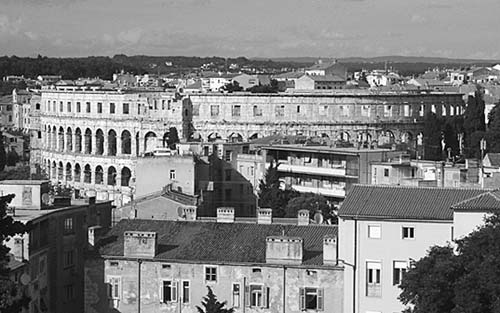
In the mid-19th century, Italian unification forced the Austrian Habsburgs—whose navy had been based in Venice—to look for a new home for their fleet. In 1856, they chose Pula, and over the next 60 years, the population grew thirtyfold. (Despite the many Roman and Venetian artifacts littering the Old Town, most of modern Pula is essentially Austrian.) By the dawn of the 20th century, Pula’s harbor bristled with Austro-Hungarian warships, and it had become the crucial link in a formidable line of imperial defenses that stretched from here to Montenegro. As one of the most important port cities of the Austro-Hungarian Empire, Pula attracted naval officers, royalty...and a young Irishman named James Joyce who was on the verge of revolutionizing the literary world.
Today’s Pula, while no longer quite so important, remains a vibrant port town and the de facto capital of Istria. It offers an enjoyably urban antidote to the rest of this stuck-in-the-past peninsula.
Pula’s sights, while top-notch, are quickly exhausted. Two or three hours should do it: Visit the amphitheater, stroll the circular Old Town, and maybe see a museum or two. As it’s less than an hour from Rovinj, there’s no reason to spend the night.
Although it’s a big city, the tourist’s Pula is compact: the amphitheater and, beside it, the ring-shaped Old Town circling the base of an old hilltop fortress. The Old Town’s main square, the Forum, dates back to Roman times.
Pula’s TI overlooks the Old Town’s main square, the Forum. It offers a free map and information on the town and all of Istria (daily June-Sept 8:00-21:00—or until 22:00 in July-Aug, May and Oct 8:00-18:00, Nov-April 9:00-16:00, Forum 3, tel. 052/219-197, www.pulainfo.hr).
By Car: Pula is about a 45-minute drive south of Rovinj. Approaching town, follow Centar signs, then watch for the amphitheater. Parking is plentiful on the streets around the amphitheater; if it’s parked up, head for the large pay lot just below the amphitheater, toward the waterfront. This lot, and any street spaces marked in blue, cost the same (4 kn/hour; if parking on street, pay at meter or buy parking voucher at newsstand to display in window).
By Bus: As you exit the bus station, walk toward the yellow mansion, then turn left onto the major street (ulica 43 Istarske Divizije); at the roundabout, bear left again, and you’ll be headed for the amphitheater (about a 10-minute walk total).
By Train: The train station is a 15-minute walk from the amphitheater, near the waterfront (in the opposite direction from the Old Town). Walk with the coast on your right until you see the amphitheater.
By Plane: Pula’s small airport, which is served by various low-cost airlines, is about 3.5 miles northeast of the center. A handy and affordable shuttle bus is coordinated to depart 20 minutes after many budget flights arrive—check for details with your airline (30 kn to downtown Pula, 90 kn to Rovinj, run by two different companies—check schedule and prebook at www.brioni.hr or www.fils.hr). Public bus #23 goes between the airport and Pula’s bus station, but it’s infrequent (10/day Mon-Fri, 4/day Sat, none Sun) and stops along the road in front of the airport rather than at the airport itself (coming from town to the airport, watch for buses to Valtura). The fair rate for a taxi into downtown Pula is about 80 kn, but most manage to charge more like 100 kn (don’t pay more than that). Airport info: Tel. 052/530-105, www.airport-pula.com.
Car Rental: All of the big rental companies have their offices at the airport (see airport info above); the TI has a list of a few local outfits with offices downtown.
Local Guide: If you’d like a guide to help you uncover the story of Pula, Mariam Abdelghani leads great tours of the major sites (€80 for a 2-hour city tour, €160 for an all-day tour of Istria, mobile 098-419-560, mariam.abdelghani@gmail.com).
(See “Pula” map, here.)
This walk is divided between Pula’s two most interesting attractions: the Roman amphitheater and the circular Old Town. About an hour for each is plenty. More time can be spent sipping coffee al fresco or dipping into museums.
• Begin at Pula’s main landmark, its...
Of the dozens of amphitheaters left around Europe and North Africa by Roman engineers, Pula’s is the sixth-largest (435 feet long and 345 feet wide) and one of the best-preserved anywhere. This is the top place in Croatia to resurrect the age of the gladiators.
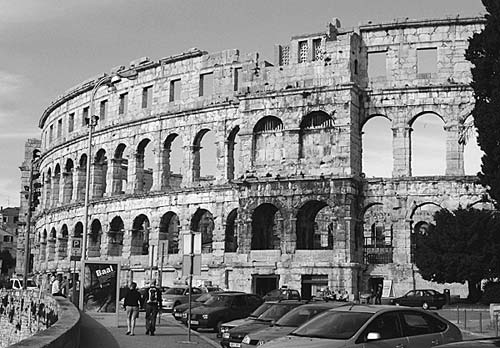
Cost and Hours: 40 kn, daily May-Sept 8:00-21:00—often later in July-Aug and for special events, April 8:00-20:00, Oct 9:00-19:00, Nov-March 9:00-17:00. The 30-kn audioguide, available at the kiosk inside, narrates 20 stops with 30 minutes of flat, basic data on the structure.
Gladiator Shows: About once each week in the summer, costumed gladiators re-enact the glory days of the amphitheater in a show called Spectacvla Antiqva (60 kn, 1/week late June-mid-Sept, details at www.pulainfo.hr).
 Self-Guided Tour: Go inside and explore the interior, climbing up the seats as you like. An “amphi-theater” is literally a “double theater”—imagine two theaters, without the back wall behind the stage, stuck together to maximize seating. Pula’s amphitheater was built over several decades (first century A.D.) under the reign of three of Rome’s top-tier emperors: Augustus, Claudius, and Vespasian. It was completed around A.D. 80, about the same time as the Colosseum in Rome. It remained in active use until the beginning of the fifth century, when gladiator battles were outlawed. The location is unusual but sensible: It was built just outside town (too big for tiny Pula, with just 5,000 people) and near the sea (so its giant limestone blocks could be transported here more easily from the quarry six miles away).
Self-Guided Tour: Go inside and explore the interior, climbing up the seats as you like. An “amphi-theater” is literally a “double theater”—imagine two theaters, without the back wall behind the stage, stuck together to maximize seating. Pula’s amphitheater was built over several decades (first century A.D.) under the reign of three of Rome’s top-tier emperors: Augustus, Claudius, and Vespasian. It was completed around A.D. 80, about the same time as the Colosseum in Rome. It remained in active use until the beginning of the fifth century, when gladiator battles were outlawed. The location is unusual but sensible: It was built just outside town (too big for tiny Pula, with just 5,000 people) and near the sea (so its giant limestone blocks could be transported here more easily from the quarry six miles away).
Notice that the amphitheater is built into the gentle incline of a hill. This economical plan, unusual for Roman amphitheaters, saved on the amount of stone needed, and provided a natural foundation for some of the seats (notice how the upper seats incorporate the slope). It may seem like the architects were cutting corners, but they actually had to raise the ground level at the lower end of the amphitheater to give it a level foundation. The four rectangular towers anchoring the amphitheater’s facade are also unique (two of them are mostly gone). These once held wooden staircases for loading and unloading the amphitheater more quickly—like the massive corkscrew ramps in many modern stadiums. At the top of each tower was a water reservoir, used for powering fountains that sprayed refreshing scents over the crowd to mask the stench of blood.
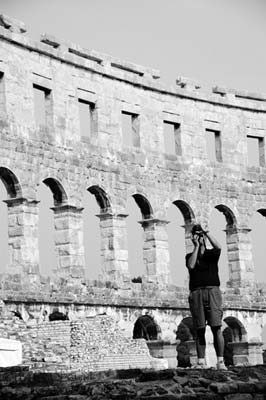
And there was plenty of blood. Imagine this scene in the days of the gladiators. More than 25,000 cheering fans from all social classes filled the seats. The Romans made these spectacles cheap or even free—distracting commoners with a steady diet of mindless entertainment prevented discontent and rebellion. (Hmm...The Voice, anyone?) Canvas awnings rigged around the top of the amphitheater shaded many seats. The fans surrounded the “slaying field,” which was covered with sand to absorb blood spilled by man and beast, making it easier to clean up after the fight. This sand (harena) gave the amphitheater its nickname...arena.
The amphitheater’s “entertainers” were gladiators (named for the gladius, a short sword that was tucked into a fighter’s boot). Some gladiators were criminals, but most were prisoners of war from lands conquered by Rome, who dressed and used weapons according to their country of origin. A colorful parade kicked off the spectacle, followed by simulated fights with fake weapons. Then the real battles began. Often the fights represented stories from mythology or Greek or Roman history. Most ended in death for the loser. Sometimes gladiators fought exotic animals—gathered at great expense from far corners of the empire—which would enter the arena from the two far ends (through the biggest arches). There were female gladiators, as well, but they always fought other women.
While the life of a gladiator seems difficult, consider that it wasn’t such a bad gig—compared to, say, being a soldier. Gladiators were often better paid than soldiers, enjoyed terrific celebrity (both in life and in death), and only had to fight a few times each year.
Ignore the modern seating, and imagine when the arena (sandy oval area in the center) was ringed with two levels of stone seating and a top level of wooden bleachers. Notice that the outline of the arena is marked by a small moat (now covered with wooden slats)—just wide enough to keep the animals off the laps of those with the best seats, but close enough so that blood still sprayed their togas.
After the fall of Rome, builders looking for ready-cut stone picked apart structures like this one—scraping it as clean as a neat slice of cantaloupe. Sometimes the scavengers were seeking the iron hooks that were used to connect the stone; in those oh-so “Dark Ages,” the method for smelting iron from ore was lost. Most of this amphitheater’s interior structures—such as steps and seats—are now in the foundations and walls of Pula’s buildings...not to mention palaces in Venice, across the Adriatic. In fact, in the late 16th century, the Venetians planned to take this entire amphitheater apart, stone by stone, and reassemble it on the island of Lido on the Venetian lagoon. A heroic Venetian senator—still revered in Pula—convinced them to leave it where it is.
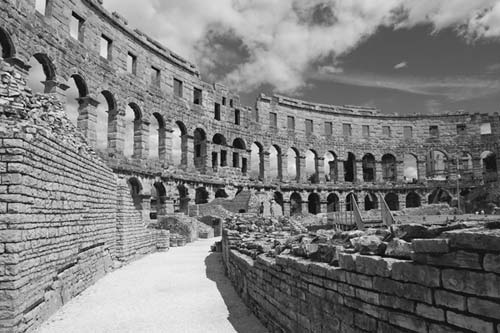
Despite these and other threats, the amphitheater’s exterior has been left gloriously intact. The 1999 film Titus (with Anthony Hopkins and Jessica Lange) was filmed here, and today the amphitheater is still used to stage spectacles—from Placido Domingo to Elton John—with seating for about 5,000 fans. Recently, the loudest concerts were banned, because the vibrations were damaging the old structure.
Before leaving, don’t miss the museum exhibit (in the “subterranean hall”—follow exhibition signs down the chute marked #17). This takes you to the lower level of the amphitheater, where gladiators and animals were kept between fights. When the fight began, gladiators would charge up a chute and burst into the arena, like football players being introduced at the Super Bowl. As you go down the passage, you’ll walk on a grate over an even lower tunnel. Pula is honeycombed with tunnels like these, originally used for sewers and as a last-ditch place of refuge in case of attack. Inside, the exhibit—strangely dedicated to “olive oil and wine production in Istria” instead of, you know, gladiators—is surprisingly interesting. Browse the impressive collection of amphorae (see sidebar), find your location on the replica of a fourth-century A.D. Roman map (oriented with east on top), and ogle the gigantic grape press and two olive-oil mills.
On your way out, check the corridor across from the ticket booth to see if there are any temporary exhibits.
• From the amphitheater, it’s a few minutes’ walk to Pula’s Old Town, where more Roman sights await. Exit the amphitheater, cross the street, turn left, and walk one long block along the small wall up the busy road (Amfiteatarska ulica). When you reach the big park on your right, look for the little, car-sized...
Use this handy model of Pula to get oriented. Next to the amphitheater, the little water cannon spouting into the air marks the pale-blue house nearby, the site of a freshwater spring (which makes this location even more strategic). The big star-shaped fortress on the hill is Fort Kaštel, designed by a French architect during the Venetian era (1630). Read the street plan of the Roman town into this model: At the center (on the hill) was the castrum, or military base. At the base of the hill (the far side from the amphitheater) was the forum, or town square. During Pula’s Roman glory days, the hillsides around the castrum were blanketed with the villas of rich merchants. The Old Town, which clusters around the base of the fortress-topped hill, still features many fragments of the Roman period, as well as Pula’s later occupiers. We’ll take a counterclockwise stroll around the fortified old hill through this ancient zone.
The huge anchor across the street from the model celebrates Pula’s number-one employer—its shipyards.
• Continue along the street. At the fork, bear right (on Kandlerova ulica—level, not uphill). Notice the Roman ruins on your right. Just about any time someone wants to put up a new building, they find ruins like these. Work screeches to a halt while the valuable remains are excavated. In this case, they’ve discovered three Roman houses, two churches, and 2,117 amphorae—the largest stash found anywhere in the world. (The harbor is just behind, which suggests this might have been a storehouse for off-loaded amphorae.) I guess the new parking garage has to wait.
After about three more blocks strolling through gritty, slice-of-life Pula, on your right-hand side, you’ll see Pula’s...
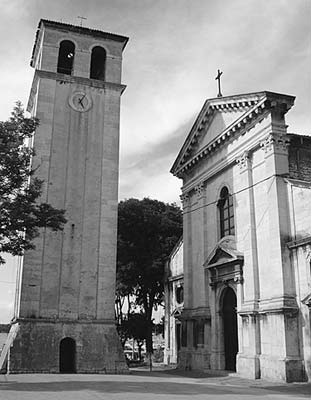
This church combines elements of the two big Italian influences on Pula: Roman and Venetian. Dating from the fifth century A.D., the Romanesque core of the church (notice the skinny, slitlike windows) marks the site of an early-Christian seafront settlement in Pula. The Venetian Baroque facade and bell tower are much more recent (early 18th century). Typical of the Venetian style, notice how far away the austere bell tower is from the body of the church. The bell tower’s foundation is made of stones that were scavenged from the amphitheater. The church’s sparsely decorated interior features a classic Roman-style basilica floor plan, with a single grand hall—the side naves were added in the 15th century, after a fire.
Cost and Hours: Free, generally open daily 10:00-18:00 in summer, less off-season.
• Keep walking through the main pedestrian zone, past all the tacky souvenir shops and Albanian-run fast-food and ice-cream joints. After a few more blocks, you emerge into the...
Every Roman town had a forum, or main square. Twenty centuries later, Pula’s Forum not only serves the same function but has kept the old Roman name.
Two important buildings front the north end of the square, where you enter. The smaller building (on the left, with the columns) is the first-century A.D. Roman Temple of Augustus (Augustov Hram). Built during the reign of, and dedicated to, Augustus Caesar, this temple took a direct hit from an Allied bomb in World War II. After the war, the Allied occupiers rebuilt it as a sort of mea culpa—notice the patchwork repair job. It’s the only one remaining of three such temples that once lined this side of the square. Inside the temple is a single room with fragments of ancient sculptures (10 kn, May-Sept Mon-Sat 9:00-20:00, Sun 10:00-15:00, often closed Oct-April, sparse English labels). The surviving torso from a statue of Augustus, which likely stood on or near this spot, dates from the time of Christ. Other evocative chips and bits of Roman Pula include the feet of a powerful commander with a pathetic little vanquished barbarian obediently at his knee (perhaps one of the Histri—the indigenous Istrians that the Romans conquered in 177 B.C.).
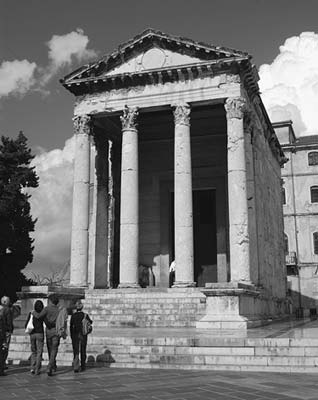
Head back out on to the square. As Rome fell, its long-subjugated subjects in Pula had little respect for the former empire’s symbols, and many temples didn’t survive. Others were put to new use: Part of an adjacent temple (likely dedicated to Diana) was incorporated into the bigger building on the right, Pula’s medieval Town Hall (Gradska Palača). If you circle around behind this building, you can still see Roman fragments embedded in the back. The Town Hall encapsulates many centuries of Pula architecture: Romanesque core, Gothic reliefs, Renaissance porch, Baroque windows...and a few Roman bits and pieces. Notice the interesting combination of flags above the door: Pula, Croatia, Istria (with its mascot goat), Italy (for the large ethnic minority here), and the European Union (which Croatia joined in 2013).
• Consider dropping by the TI on this square before continuing our circular stroll down the main drag, Sergijevaca. You’ll pass by a small park on your right, then a block of modern shops. Halfway along the second building on the right—after the Calzedonia shop—watch for the poorly marked doorway with a green Roman mosaic plaque next to it. Go through the door and down the corridor (often occupied by vendors), and pop out the back door. Emerging on the other side, turn left, walk to the metal grill, and look down to see the...
This hidden mosaic is a great example of the Roman treasures that lie below the old center of Pula. Uncovered by locals who were cleaning up from World War II bombs, this third-century floor was carefully excavated and cleaned up for display right where it was laid nearly two millennia ago. (Notice that the Roman floor level was about six feet below today’s.) The centerpiece of the mosaic depicts the punishment of Dirce. According to the ancient Greek legend, King Lykos of Thebes was bewitched by Dirce and abandoned his pregnant queen. The queen gave birth to twin boys (depicted in this mosaic), who grew up to kill their deadbeat dad and tie Dirce to the horns of a bull to be bashed against a mountain. This same story is famously depicted in the twisty Toro Farnese sculpture partly carved by Michelangelo (on display in Naples’ Archaeological Museum).
• For an optional detour to Byzantine times, walk into the parking lot just beyond the mosaic. Near the end of the lot, on the left-hand side, is a fenced-off grassy field. At the far end of the field is the small...
We’ve seen plenty of Roman and Venetian bric-a-brac, but this chapel survives from the time of another Istrian occupier: Byzantium. For about 170 years after Rome fell (the sixth and seventh centuries A.D.), this region came under the control of the Byzantine Empire and was ruled from Ravenna (now in Italy, across the Adriatic, south of Venice). Much of this field was once occupied by a vast, richly decorated basilica. This lonely chapel is all that’s left, but it still gives a feel for the architecture of that era—including the Greek cross floor plan (with four equal arms) and heavy brick vaulting.
• Back on the main drag (Sergijevaca), continue through Pula’s most colorful and most touristy neighborhood. After a block, the stepped lane on the left leads up to the deconsecrated Church of the Holy Cross, which is now a state-of-the-art museum space housing temporary exhibits from the Archaeological Museum (explained on here).
Continuing along Sergijevaca, in a few short blocks you’ll arrive at the...
This triumphal arch, from the first century B.C., was Michelangelo’s favorite Roman artifact in Pula. Marking the edge of the original Roman town, it was built to honor Lucius Sergius Lepidus. He fought on the side of Augustus in the civil wars that swept the empire after Julius Caesar’s assassination. The proto-feminist inscription proudly explains, “Silvia of the Sergius family paid for this with her own money.” Statues of Silvia’s husband, Lucius, plus her son and her brother-in-law, once stood on the three blocks at the top of the arch. (Squint to see the Sergivs name on each block.) On the underside of the arch is a relief of an eagle (the symbol of Rome) clutching an evil snake in its talons.

• Before going under the arch, look to your left to see a famous Irishman appreciating the view from the terrace of...
In October 1904, a young writer named James Joyce moved from Dublin to Pula with his girlfriend, Nora Barnacle. By day, he taught English to Austro-Hungarian naval officers at the Berlitz language school (in the yellow building nearby). By night, he imagined strolling through his hometown as he penned short stories that would eventually become the collection Dubliners. But James and Nora quickly grew bored with little Pula and moved to Trieste in March 1905. Even so, Pula remains proud of its literary connections.
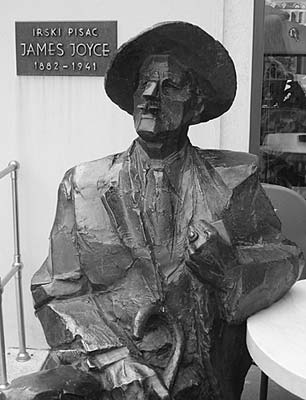
• Now pass through the arch, into a square next to some remains of the town wall. Continue straight ahead (up two bustling blocks, along the in-love-with-life Flanatička street) to...
Pula’s market hall was an iron-and-glass marvel when inaugurated in the 19th century. This structure is yet another reminder of the way the Austro-Hungarian Empire modernized Pula with grace and gentility. You’ll find meats, cheeses, and smelly fish on the ground floor (Mon-Sat 7:00-13:30, Sun 7:00-12:00), and an inviting food circus upstairs (Mon-Fri 7:00-15:00, Sat 7:00-14:00, Sun 7:00-12:00). All around is a busy and colorful farmers market that bustles until about 13:00, when things quiet down.
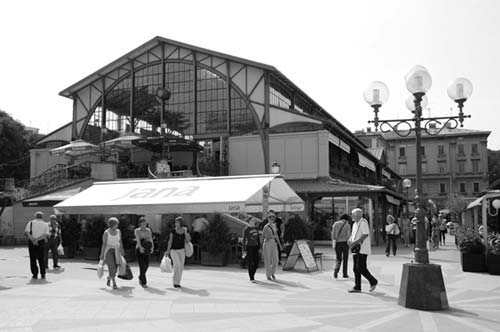
• Our tour is finished. If you’re ready for lunch, consider one of the cheap options inside or near the market hall, or walk one block to Kantina (see “Eating in Pula,” later).
When you’re done here, backtrack to the town wall. As you face the Arch of Sergius, take a right and walk under the leafy canopy next to the wall. Keep an eye out (mostly on your left, along the wall) for more Roman remains. Among these are the Twin Gates (Porta Gemina), marking the entrance to a garden that’s home to the Archaeological Museum of Istria (described next). You’ll also see entrances to the Austro-Hungarian-era tunnels that burrow under the hill; called Zerostrasse, this space often hosts special exhibits. With more time, you can also consider a trip to the hilltop fortress, Fort Kaštel. Otherwise, we’ve completed our circular tour—the amphitheater is just around the corner.
Pula’s century-old archaeological museum (at Carrarina 3) is closed for renovation for several years. When open, it shows off some of what you’ve seen in the streets, plus lots more—stone monuments, classical statues, ancient pottery...you name it. While it’s closed, temporary exhibits drawing from the collection’s highlights are displayed a few blocks away, inside the Church of the Holy Cross. Beautifully restored and repurposed as a modern exhibition space, and with good English descriptions, it’s arguably a more satisfying home for the collection. Historians will want to check out the latest exhibits.
Cost and Hours: 20 kn—but can change depending on exhibits, daily 9:00-23:00, until 21:00 off-season, www.ami-pula.hr.
The remains of an ancient theater are free to visit, on the hill behind the (currently closed) Archaeological Museum. Part of the stage is still intact, along with the semicircle of stone seats (some of which are still engraved with the names of the wealthy theatergoers who once sat in them). To find it, go up the hill around the right side of the museum. This was the smaller of the two theaters in Roman Pula; the second was south of the center (and is no longer intact).
For a bird’s-eye view over the town, head up to its centerpiece fortress. This deserted-feeling place, hosting the Historical Museum of Istria, is worth visiting only for the chance to wander the ramparts. While neither the museum nor the fortress is worth the hike up here, it’s a good way to kill some extra time in Pula and sample the views over the town and amphitheater (various trails lead up from the streets below).
The best lunch options are in and near the town’s market hall (which is also where my self-guided walk ends). The top floor of the market is a food circus with a number of cheap and tempting eateries with both indoor and terrace seating. Back outside, around the right side of the market hall, you’ll find a pair of fiercely competitive bakeries serving fresh batches of cheap and delicious burek, the savory phyllo-dough pastry. One no-name bakery is built into the market hall itself, and Pekarna Corona faces it from across the market square.
Kantina Restaurant, a block away, serves good lunches (including veggie options) and hearty, creative 35-kn salads both in an elegant vaulted cellar and on a lazy shady terrace. The service can be slow—if you’re in a rush, eat at the market hall instead (60-85-kn pastas, 90-150-kn meat dishes, daily 12:00-23:00, closed Sun off-season, at the end of the pedestrian zone at Flanatička 16, tel. 052/214-054).
By Bus from Pula to: Rovinj (about hourly, 45 minutes), Poreč (9/day, 1.5 hours), Opatija (12-14 day, 2 hours), Rijeka (nearly hourly, 2-2.5 hours), Zagreb (almost hourly, 4-6 hours), Split (2/day, 10 hours, plus 1 night bus—described next), Venice (1/day departing at 5:00, arrives Venice 10:15). A night bus departs Pula at 20:00, going to Split (arrives 6:00), where you can connect to Dubrovnik (arrives 11:00). To reach destinations in Slovenia (including Piran and Ljubljana), most connections require a change in Umag. In the summer (July-Sept only), a handy, express, direct bus departs at 16:00 and heads for Rovinj (30 min), then Piran (3 hours) and Ljubljana (5 hours). Or you can take the 8:00 bus from Rovinj (late June-Aug only, described on here). Year-round, two days a week you can take a very early bus from Pula to Portorož (with a connection to Piran) and then on to Ljubljana (departs Pula at 5:30). Slovenia connections are run by Fils Pula (confirm schedules at www.fils.hr). In the summer, be aware that bus connections are more frequent on weekdays (fewer departures Sat-Sun). Bus info: Toll tel. 060-304-090.
By Train to: Zagreb (3/day, 6 hours, transfer in Rijeka), Ljubljana (1/day mid-July-Aug Thu-Sun only, 5 hours, transfer in Hrpelje-Kozina).
The Brijuni Islands (bree-YOO-nee, Brioni in Italian)—an archipelago of 14 islands just offshore from the southern tip of the Istrian Peninsula—were a favorite haunt of Marshal Tito, the leader of communist Yugoslavia. The main island, called Great Brijuni (Veli Brijun), was where Tito liked to show off the natural wonders of his beloved Yugoslavia to visiting dignitaries and world leaders. Today the island is a national park that combines serene natural beauty with quirky Yugoslav sights—offering a strange but enjoyable time capsule of the Tito years.
As you’ll see from the remains of previous occupants (Romans, Byzantines, Venetians, Austrians—even dinosaurs), Tito wasn’t the first to fall in love with Brijuni. Its first tourist boom came at the turn of the 20th century, when Austrian entrepreneur Paul Kupelwieser developed Brijuni into a world-class health resort. Between the World Wars, it hosted many notables, from Douglas Fairbanks and John D. Rockefeller to Richard Strauss and Hirohito. But when Tito took power, he claimed the islands for himself, making Brijuni his summer residence from 1949 until 1979. During this time, the island hosted a steady stream of VIP visitors from the East, the West, and the non-aligned world (see sidebar). Just three years after Tito’s death, in October 1983, Brijuni opened to the public as a national park.
Getting There: You can get to Great Brijuni Island only on one of the national park’s boats. These depart from the town of Fažana, five miles north of Pula and 20 miles south of Rovinj. From Rovinj, drive southeast to Bale, where you’ll get on the ipsilon highway and continue south. In Vodnjan, watch for the easy-to-miss turnoff (on the right) marked for Fažana and Brijuni. Once in Fažana, follow brown Brijuni signs and park along the water (confirm with park ticket office that your parking spot is OK).
Cost and Information: The price varies depending on the time of year: July-Aug-210 kn, June and Sept-200 kn, April-May and Oct-170 kn, Nov-March-125 kn; includes park entry, round-trip by boat to the island, and a guide (see “English Tour,” below). Tel. 052/525-882, www.brijuni.hr.
Hours: From April through October, the first boat departure from Fažana is at 6:45 and the last trip is at 21:45 (last return from Brijuni at 23:00). The number of departures varies with the time of year: May-Sept about hourly, 12/day; March-April and Oct 8/day; Nov-Feb 4/day.
English Tour: You’re required to go to the island with a four-hour guided tour, much of which is spent on a little tourist train. The only English-language tour usually departs Fažana daily at 11:30. It’s essential to call ahead to confirm the schedule and reserve a space on the tour (call or email at least a day before, or three days ahead in peak season, tel. 052/525-883, izleti@brijuni.hr).
If you can’t make it on the English tour, you’re welcome to join any tour you like (Croatian, German, Italian, etc.). While it’s possible to slip away from your group and explore the island on your own, park officials discourage it. (But, since hotel guests on the island can move about freely, it’s generally no problem.) Staying with the tour for most of the trip is wise in any event, as there’s lots of ground to cover in a limited amount of time. It’s possible to rent bikes at the hotel where the boat puts in. You’re technically required to take the same boat back with the rest of your tour, but this isn’t closely monitored.
Visiting the Island: Great Brijuni Island can be visited only with a tour (described above). After a 15-minute crossing from the mainland town of Fažana, visitors arrive at the island’s main harbor, which is a hub of activity and the site of its two hotels. Outside this area, the island is largely undeveloped, with just a few tourist facilities and houses of people who live here. There are virtually no cars—most people get around by bike, golf cart, or the little tourist train you’ll board to begin your tour. As you spin around the island, you’ll enjoy views over its endlessly twisty coast, with cove after tranquil cove. Your guide will impart both dry facts and eye-rolling legends while you putter past several intriguing sights, periodically giving you a chance to get off the train and explore a few of them up close.
The tour’s highlight is the “Tito on Brijuni” exhibit. Dating from 1984—four years after his death, but before the end of Yugoslavia—this exhibit celebrates the cult of personality surrounding the head of this now-deceased nation. The museum (with English descriptions) features countless photos of Tito in every Brijuni context imaginable—strolling, sunbathing, skeet shooting, schmoozing with world leaders and movie stars, inspecting military officers, playing with camels given to him by Muammar al-Gaddafi, and so on. (For more on Tito, and why this former dictator remains so beloved in his former lands, see the sidebar on here.) Smaller side-exhibits include a taxidermy collection of exotic animals given to Tito by foreign leaders from around the world and photos of Paul Kupelwieser, the Austrian magnate who put Brijuni on the tourist map.
Another high point of the island tour is the safari, featuring a diverse menagerie of animals (or their descendants) brought here for Tito as gifts by visiting heads of state. Because many of the non-aligned nations are in Africa, Asia, or other non-European regions, some of these beasts are particularly exotic. Aside from the Istrian ox and Istria’s trademark goat, you’ll see llamas, Somali sheep, Shetland ponies, chamois, and more. Your train may stop for a visit with Sony and Lanka, a pair of Indian elephants given to Tito by Indira Gandhi, the former prime minister of India. There once were camels, cheetahs, ostriches, monkeys, bears, and bobcats as well, but most of these have gone to the great non-aligned safari in the sky, and their bodies are now preserved at the “Tito on Brijuni” exhibit.
Other attractions you may see on Brijuni: an ancient, gnarled olive tree supposedly dating from the fourth century A.D.; the remains of a mostly first-century A.D. Roman villa rustica (country estate); the ruined street plan of a Byzantine fort; a 15th-century Gothic church with an exhibit on frescoes and Glagolitic (early Croatian) script; a Venetian summer house that hosts an archaeology museum; an Austro-Hungarian naval fort (Brijuni was strategically important back when Pula was Austria’s main naval base); and footprints left by a dinosaur who vacationed here 120 million years before Tito.
Birders can look for some of the 250 avian species that live on the island in the summer. Gardeners may spot some exotic, non-native plant species (more gifts, to go along with all those animals), such as Australian eucalyptus. And Republicans can drool over the golf course, a reminder that Brijuni is attempting to cultivate a ritzy image. Your tour’s lengthy stop at the bar/gift shop is yet another indication that, while some remember Tito fondly, good ol’ capitalism is here to stay.
When you tell Europeans you’re going to Istria, they say, “Ah, you must go to Poreč!” Poreč (poh-RETCH, Parenzo in Italian), the tourist capital of the Istrian coast, is the kind of resort that brags about how many hotel beds it has, rather than how many museums, churches, or gelato stands are packed into its Old Town. It’s also proud to have more than its fair share of “blue-flag beaches” (called lagunas)—meaning that the water is crystal-clear for swimming. Finally, Poreč has won several “Croatia’s cleanest city” contests. None of this makes for very compelling sightseeing, but...there you go.
Despite the town’s appeal to European holiday-makers, most American visitors find Poreč too big to be charming, but too small to be exciting. Its only real sight is the basilica, with its exquisite mosaics. Beyond that, it’s mostly interesting as a case study on how Germans like to vacation: Set up camp for a week at a distant resort hotel, bake in the sun, and occasionally trek into the Old Town for dinner. Think of it as the Croatian Acapulco.
For the typical speedy American visitor, spending time in Rovinj, Piran, Pula, or the Istrian interior is more satisfying. If you’re still curious, see Poreč en route or as a day trip: Zip in, stroll the Old Town, ogle the mosaics in the basilica, then move on. Despite its many hotels, Poreč lacks soul—I prefer sleeping elsewhere.
Like so many Croatian coastal towns, the Old Town of Poreč is on a peninsula. Surrounding it are miles of hotels-and-concrete sprawl. Traffic into the city funnels into Zagrebačka street, which passes the TI and ends at the spacious square named Trg Slobode. From there, Decumanus street marches straight through the middle of the Old Town.
Visit the TI to pick up the information booklet, sightseeing guide, and city map (July-Aug daily 8:00-21:00; progressively shorter hours and closed Sun off-season; a few steps from Trg Slobode at Zagrebačka 9, tel. 052/451-293, www.to-porec.com).
The bus station and big parking lot straddle the base of the Old Town.
Drivers follow Centar and blue P signs to reach the big lot nearest the Old Town (8 kn/hour, 50 kn/day, take ticket as you enter and bring it with you; when leaving Poreč, pay at the kiosk before returning to your car, then wave paid ticket at exit to open gate). From the lot, walk uphill past the parking kiosk and the market until you reach big Zagrebačka boulevard, with the grass median. Turn right and continue up Zagrebačka, passing the TI (on your right) en route to Trg Slobode and the Old Town.
The bus station is at the other end of the Old Town. Exit the station to the right and go through the little park to the seafront and Old Town. Just up the hill is Trg Slobode and the nearby TI.
This sixth-century church is a gold mine for fans of Byzantine mosaics. The otherwise dull interior is dominated by gorgeous, glittering mosaics in the apse surrounding the main altar. The top row depicts Jesus surrounded by the 12 apostles, the medallions around the arch celebrate 12 female martyrs, and front and center are Mary and Jesus surrounded by angels and martyrs—including Bishop Euphrasius, holding his namesake basilica in his arms (second from left). These date from the 170-year period after the fall of Rome (roughly 530-700 A.D.), when Istria was part of the Byzantine Empire and was ruled from Ravenna (near Venice, across the Adriatic). The more recent (13th-century) canopy over the altar was inspired by the one in St. Mark’s Basilica in Venice. Don’t miss another set of mosaics in the floor just inside the door.

For more mosaics, drop into the attached museum, with several mosaic fragments scattered around two floors. Or climb the bell tower to get a bird’s-eye view of Poreč. Both are included in the basilica ticket.
Cost and Hours: 30 kn, basilica open long hours daily, no shorts; museum and tower open April-Sept daily 10:00-17:00, likely closed Oct-March; a block off the Old Town’s main drag on—where else?—Eufrazijeva street; as you walk down the main street, Decumanus, look for the archway with gold mosaics down Sv. Eleuterija street.
From Poreč by Bus to: Rovinj (3-6/day, 1 hour), Pula (9/day, 1.5 hours), Piran (2/day Mon-Fri, 1/day Sat-Sun; additional departures to Portorož, near Piran).
Most tourists in Croatia focus on the coast. For a dash of variety, head inland. Some of the best bits of the Croatian interior lie just a short drive from Rovinj. Dotted with picturesque hill towns, speckled with wineries and olive-oil farms, embedded with precious truffles, and grooved by meandering rural roads, the Istrian interior is worth a visit. Tucked below, between, and on top of the many hills are characteristic stone-walled villages, designed to stay cool in summer and warm in winter. The local tourist board is carefully manicuring this region’s image as the hot new spot to find hill towns, backcountry drives, and a relaxed and relaxing lifestyle. The often-repeated comparisons to Tuscany and Provence are a stretch. The Istrian landscape is not as idyllic or as stunningly beautiful as those places, the towns here are sleepy and lack vibrancy, and because of the area’s complex history, the culture is less deeply rooted. But many visitors still find themselves seduced by the malvazija wine, truffles, picturesque tableaus, and laid-back ambience of the Istrian hill towns.
Poking around and exploring on your own is a good option here. For a quick visit, focus on the best hill town: Motovun, a popular little burg with sweeping views. With more time, consider venturing deeper into the smaller villages that sit above the Mirna River Valley—the scenic, deserted, lost-in-a-time-warp village of Završje; the rugged, relatively untrampled artists’ colony of Grožnjan; or the bigger towns of Buje and Oprtalj. Farther east—on the way to Rijeka—is the extremely remote and miniscule, yet touristy, hamlet of Hum.
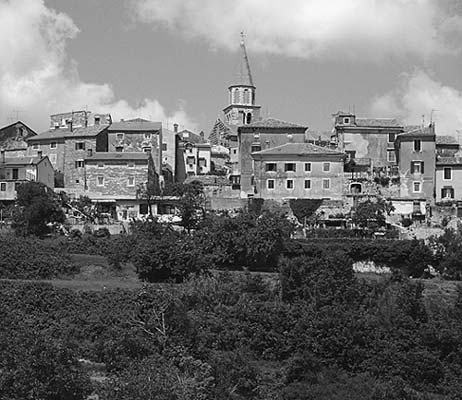
One of the interior’s main draws is its cuisine—especially the truffles that are found right here, as fresh as you can get. While Rovinj has some fine restaurants, it’s worth planning your day around having lunch or dinner in the interior. Motovun has several excellent options—Mondo Konoba is tops—or you can head for the countryside: For the ultimate rustic rest stop (but with few truffles), dine at Konoba Astarea in Brtonigla; for truffle dishes surrounded by the forests in which they’re foraged, you can go upscale at Zigante in Livade, or venture into the nearby countryside to enjoy the more rustic truffle dishes at Konoba Dolina in Gradinje. All of these are described later in more detail. The price ranges I’ve given for restaurants in this area are extremely wide—you can assume that the top-end dishes are truffle splurges, such as steak with white truffles (white truffles are most expensive, followed by black truffles...followed by everything else on the menu).
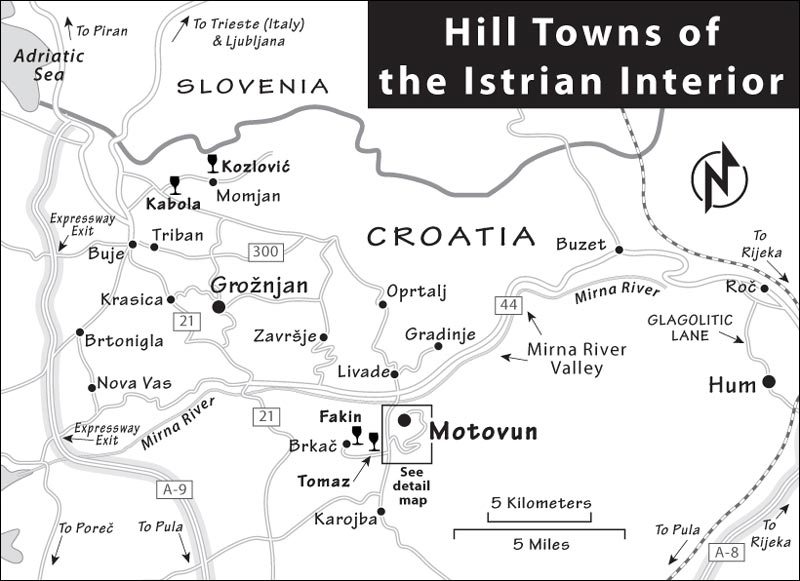
During the glory days of the Austro-Hungarian Empire, a twisty railway called La Parenzana (Porečanka in Croatian) connected Trieste to Poreč by way of many of northwest Istria’s hill towns. While the train itself is long gone, part of its route has been converted to a “rails-to-trails” path (you’ll see signs for this around the area, and a small museum in Livade), and the many bridges and tunnels engineered to make the train line possible have become nostalgic icons of an earlier time. While Croatia hasn’t yet developed a serious bicycle-tourism culture, La Parenzana is an impressive first effort. Ask locally for the free EU-funded map of La Parenzana’s route, which spans three countries (Italy, Slovenia, and Croatia).
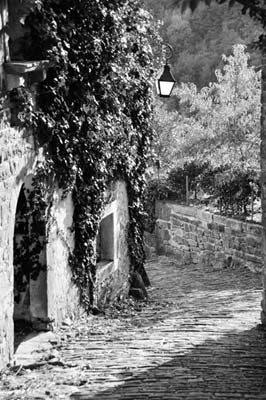
You may notice that the Istrian hill towns are, in places, pretty rough and rugged. Many are abandoned, only recently having been rediscovered by artists. Remember that after Istria shifted from Italy to Yugoslavia following World War II, the “Italian exodus” saw many local peasants leave their homes behind and move into Italy proper—one reason many of these towns are still in such disrepair. Stumbling over cobbles between desolate buildings in a village that once must have been humming with life, you may find yourself thinking about the sadness that comes with cultural population shifts.
As you explore, you’ll see frequent signs for wineries, olive-oil producers, and truffle shops. There’s an itinerary for every interest, and the Istrian tourist board publishes a stack of well-produced brochures on every topic you can imagine (available at local TIs). One recent trend in Istria is the emergence of agroturizams. Like Italian agriturismos or Slovenian tourist farms, these are working farms that try to involve tourists in a meaningful way—sometimes just for a meal or overnight stay, but occasionally actually participating in the daily workings of the farm. For more information, pick up the free brochure (available locally), or visit www.istra.hr.
By Public Transportation: While it’s possible to see some parts of inland Istria by public transportation, the rewards are not worth the headaches. The large hill town of Pazin is the region’s transit hub, with buses to Rovinj, Pula, Poreč, and Motovun—but not the smaller villages.
By Car: The region is ideal by car. For a quick visit to only the best hill town (Motovun), just zip on the ipsilon highway (A-9) to the Nova Vas exit, and take the mercifully flat road 44 along the Mirna River Valley straight to Motovun. But for a full day of hill town-hopping in the Istrian interior, follow my suggested route in the “More Hill Towns” section, later.
Dramatically situated a thousand feet above vineyards and a truffle-filled forest, Motovun (moh-toh-VOON, Montona in Italian, pop. 531) is the best-known and most-touristed of the Istrian hill towns. And for good reason: Its hilltop Old Town is particularly evocative, with a colorful old church and a rampart walk with the best spine-tingling vistas in the Istrian interior. It’s hard to believe that race-car driver Mario Andretti was born in such a tranquil little traffic-free hamlet. Today Motovun’s quiet lanes are shared by locals, tourists, and artists—who began settling here a generation ago, when it was nearly deserted.
Motovun is steep. Most everything of interest to tourists is huddled around its tippy-top. The main, upper entrance gate into town deposits you at the main square, with the church on your left and Hotel Kaštel on the right. From there, you’re just about two blocks in every direction from a sheer drop-off. This hilltop zone is circled by an old rampart that today offers Motovun’s most scenic stroll.
Motovun’s TI comes and goes (tel. 052/681-726, www.tz-motovun.hr). Fortunately, the reception desk at Hotel Kaštel kindly dispenses tourist information. Ask for the free map of Motovun and surroundings, which lists restaurants, shops, wineries, and accommodations.
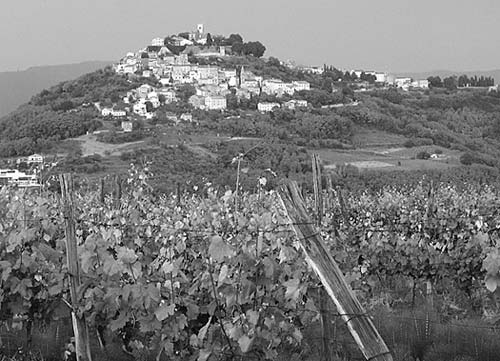
Motovun’s striking hilltop setting comes with a catch: Visitors usually have to hike up part of the way. A steep, twisty road connects the base of the hill with the Old Town up top. If it’s not too crowded, drive as far up this road as possible until you’re directed to park in the lot partway up (near the lower church, a steep 10-minute uphill walk to the main square, 22 kn/day). On very busy days, this lot can fill up; in this case, the parking attendant at the foot of the hill will direct you to park in the lot there, then ride the shuttle bus up. If you’re staying at Hotel Kaštel, follow the procedure explained under “Sleeping in Motovun,” later. If staying elsewhere, ask your soba host for advice.
The following commentary will bring some meaning to your Motovun hilltop stroll. The walk begins at the traffic barrier halfway up the hill (the highest you can drive unless you’re sleeping at Hotel Kaštel).
The main drag leading up into town is lined with wine-and-truffle shops. My favorite is the Lanča family’s Etnobutiga ČA (just above the parking lot on the right, at Gradiziol 33). This restored 17th-century house has a beautiful view terrace and a wide selection of local wines, brandies, and truffle products (most of them from the Zigante company, just across the valley); they also have a restaurant with grand views (Pod Napun). Like many people around here, Livio Lanča makes his own mistletoe brandy laced with honey (Easter-Oct daily 10:00-22:00, off-season closed Mon, closed Feb-mid-March, tel. 052/681-767).
Hike several more steep minutes up the hill, passing more local-products shops, truffles, and jewelry boutiques. Soon you’ll reach yet another traffic barrier at the base of the town’s wall (and the recommended Mondo Konoba restaurant). Continuing up past the barrier, you’ll earn grand views on the right—the little town across the valley floor is Livade, the heart of all that truffle commerce—then go through the first of two defensive gateways. Inside this passage (under the fortified gate), notice the various insignias from Motovun’s history lining the walls—look for the Venetian lion, the Latin family tombstone, and the seal of Motovun (with a pyramid of five towers being watched over by an angel). The area above the gate was a storehouse for weapons in the 15th century, when Motovun first flourished.
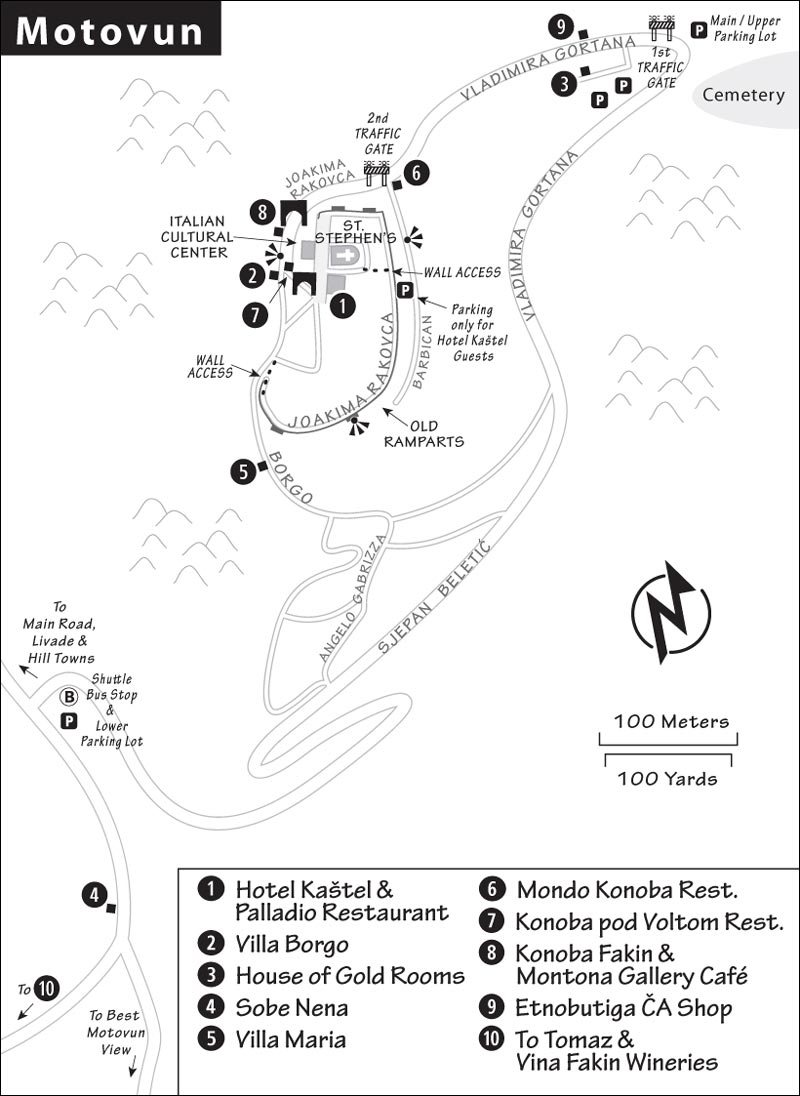
Emerging from the gateway, you’re greeted by more sweeping views of the valley below on your right-hand side. (A coffee or light meal with this view is unforgettable; the town’s lone ATM is to your left.) Just up and to the left, you’ll find another defensive gateway, which is the main entrance into the heart of the Old Town. (Inside this gateway, notice the recommended Konoba pod Voltom restaurant.)
To your left as you come through the main gate is the yellow town church, St. Stephen’s. The crenellated tower is a reminder of a time when this hilltop town needed to be defended. While unassuming from the outside, this austere house of worship has an impressive pedigree: It’s based on designs by the famous Venetian architect Andrea Palladio (1508-1580), who greatly influenced the Neoclassical architecture of Washington, DC. The interior is a little gloomy but refreshingly lived-in—used more by locals than by tourists. On the left, notice a painting of the heart of Jesus, its eyes following you around the church (free, generally open daily 10:00-18:00 and during frequent services).
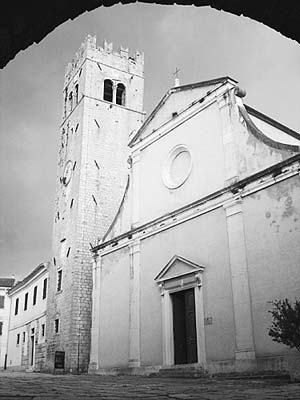
As you stand on the square in front of the church, imagine Motovun during its annual film festival, when it’s filled with 20,000 movie lovers from throughout the region and around the world—often including a minor celebrity or two. This square fills to capacity, and films are projected on a giant screen at the far end (generally late July or early Aug, www.motovunfilmfestival.com).
Facing the church is the Italian Cultural Center, which plays an important role in this very Italian corner of Croatia. While the building is not open to the public, if your timing is right you’ll enjoy beautiful music spilling out from its windows and filling the square. The local klapa music troupe—with men’s voices harmonizing a cappella—practices here twice weekly (usually Mon and Fri evenings, at 21:00 in summer and 20:00 in winter, www.klapamotovun.com). If you hear them, find a bench and enjoy the show.
At the other end of the square is a leafy little piazza dominated by the big, pink Hotel Kaštel—the main industry in town. This is also where bigwigs in town for the local film festival call home—ask the staff about recent sightings of B-, C-, and D-list celebrities. (For example, if you’re staying here, you may be showering in the same bathroom once graced by Jason Biggs, star of American Pie. Lucky you.)

Between the church and Hotel Kaštel, follow the lane to the ramparts. Take the five-minute stroll around the Old Town on these fortifications. While most of Croatia is overrun by stray cats, Motovun seems populated by dog lovers. If you see or hear dogs in people’s backyards, it’s a safe bet that they are trained to hunt for truffles in the surrounding forest.
As you breathe in the stunning panorama, notice that well-defended Motovun has been fortified three times—two layers of wall up top, and a third down below.
Because it’s not on the coast, Motovun’s accommodations don’t charge extra for one- or two-night stays. In fact, if you’re staying for three or more nights, try to score a discount. Except for the big hotel, all of the places here keep the same rates all year long. Most Motovun accommodations lack air-conditioning; thick old walls and a nice breeze generally keep things cool.
$$ Hotel Kaštel, dominating Motovun’s hilltop (and its tourist industry), is can-do, ideally located, and the only real hotel in this little burg. Most of the 33 colorful rooms have views. True to its name, the building used to be a castle, so the floor plan can be confusing (Sb-€65/€61/€57, standard Db-€110/€103/€96, Db suite or “superior” Db with air-con-€134/€126/€116, “exclusive” Db with air-con and balcony-€165/€154/€142; 10 percent discount with this book if you book direct, elevator, air-con only in some rooms, laundry service, free Wi-Fi, Trg Andrea Antico 7, tel. 052/681-607, www.hotel-kastel-motovun.hr, info@hotel-kastel-motovun.hr). Guests have free access to part of the spa facilities, with a beautiful indoor pool and a spa offering a wide range of massages (starting at 150 kn/30 min, 10 percent discount with this book). Guests with cars should tell the attendant at the traffic barrier that you have a reservation here; if there’s room on top, he’ll let you drive up. Otherwise he’ll tell you where to park and call the hotel, which will send down a free car to shuttle you up (runs until about 18:00); either way, call ahead to the hotel to figure out your options.
$ Villa Borgo, beautifully located next to the loggia just below Motovun’s uppermost gate, has 11 simple but stylish rooms with a nice budget flair. There are several types of rooms: with grand views (Db-€71/€58), with no views (Db-€61/€52), top-floor rooms that share a bathroom (D-€42), and a big apartment (Db-€82/€62, extra bed-€16). All rooms share a spectacular view terrace (lower prices are for Nov-May, includes breakfast, no air-con but fans, free Wi-Fi, April-Oct staffed until 20:00, off-season call first, Borgo 4, mobile 098-434-797, tel. 052/681-708, www.villaborgo.com, info@villaborgo.com).
$ House of Gold is an injection of creativity in creaky old Motovun, filling a historic house on the road up into town with modern, minimalist, artsy decor. Youthful but still respectable—and just the right kind of funky—the three rooms share a common room with a big-screen TV, wood stove, and kitchen (non-view Sb-€35, bigger view Db-€65, huge attic Db-€75, includes breakfast, 2-night minimum, cash only, free Wi-Fi, just above the middle parking lot at Gradziol 46, mobile 098-353-968, www.motovunaccommodation.com, brankarusnov@gmail.com, Branka). It’s on the main road just above the parking lot halfway up into town—a steep 10- to 15-minute walk to the main square. Enter through the back alley: Head up the main street to the first parking lot on the left (marked ulica Fossal); hook right at the end of the parking lot, and walk along the path until you see the golden dwarf.
$ Sobe Nena, run by Nevija and Ricardo, is a good budget option in a tidy house at the very bottom of Motovun’s hill. The two rooms are old-fashioned and basic, sharing a bathroom, but there’s a fine garden to relax in. Ricardo speaks only a little English (Nevija speaks none), but they can call their daughter Doris to translate if necessary. It’s a steep hike up into town, but you can catch the shuttle bus from the lower parking lot (if it’s running), or—if you have a car—drive up to the parking lot partway up the hill (S-€20, D-€40, cash only, across from the gas station at Kanal 32, tel. 052/681-719, mobile 099-609-0883, sobe.nena@gmail.com).
$ Villa Maria is a good value, offering two fine rooms with view terraces, plus a third non-view room, in the Sviličić family home on a quiet back lane just below the main part of town (Db-€50, breakfast-€5, cash only, air-con, free Wi-Fi, facing the defensive gate turn right and go down and around to Borgo 32, tel. 052/681-559, lorenasvilicic@gmail.com).
Considering this is a small hill town with just a few real restaurants, all of them are impressively good; the first two listings are particularly notable. Every menu is topped by pricey (but tasty) truffle dishes—but keep in mind that these are a better investment when truffles are in season and the flavors are pungent (see sidebar, next page; otherwise you’ll get older, blander truffles. Remember, there are also several excellent restaurants in the countryside near Motovun—if you’re serious about food, before choosing, be sure to peruse your options in the “More Hill Towns” section, later.
Mondo Konoba, run by a Croatian-Italian hybrid family and located just below the lower town gate (on the left, at the base of the wall), serves up Sicilian-Istrian fusion cuisine that ranks with any restaurant in the region. Most diners skip the unpretentious, pastel-blue dining room in favor of the inviting little outdoor terrace, with more tables across the street at the base of the town wall. The Mondo family’s pack of five truffle-hunting dogs occasionally pays a visit (60-100-kn pastas, 95-185-kn main courses, June-Sept daily 12:00-15:30 & 18:00-22:00, closed Tue Oct-May and all of Jan, Barbakan 1, tel. 052/681-791).
Konoba pod Voltom is actually inside the town’s upper, main gate (on the right, with the Taberna sign above the door). Motovun’s most traditional eatery serves excellent, well-presented Istrian food in a cozy dining room. In good weather (June-Sept only), it’s hard to beat their view loggia, just below and outside the gate (45-60-kn pastas, 60-110-kn main courses, 80-260-kn truffle splurges, daily 12:00-22:00, closed Jan, tel. 052/681-923).
Other Scenic Eateries: Two other, simpler places also have seating along the wall, with these same mammoth views. Konoba Fakin, run by the winemaking family of the same name (see sidebar on here), offers a short menu of Istrian dishes (45-90-kn pastas, 50-145-kn main dishes, daily 10:00-24:00, tel. 052/681-598). The Montona Gallery café, with tables along the rampart between the two gates, serves drinks, ice cream, snacks, and 30- to 60-kn pizzas (daily 9:00-24:00, tel. 052/681-754).
On the Main Square: Hotel Kaštel’s Palladio Restaurant has ambitiously executed food and delightful seating right on the leafy main square—but I’d skip the dull interior (50-80-kn pastas, 70-165-kn main dishes, 10 percent discount with this book, daily 7:00-22:00; also listed under “Sleeping in Motovun,” earlier).
While Motovun is the top hill town, a charm bracelet of appealing villages sits close by it; exploring them on your drive can make for a perfect day. Some are better for visiting (Grožnjan, Završje), others better for a meal (Brtonigla, Livade), and others worth a quick stop if you’re passing through (Buje, Oprtalj, Hum). I’ve listed these roughly in the order you’ll reach them, coming from the highway and working your way toward Motovun. While you’ll traverse some slow and windy roads, this entire trip is quick—you could do the full circle (including Hum) without stops in less than three hours. This route is just a rough framework. Venture off it. Run down leads from locals. Follow intriguing signs to wine-tastings, restaurants, and agroturizams. Sniff out some truffles in the Motovun Forest. You will see some other tourists, but this area isn’t overrun...yet. There may just be some overlooked gems in the Istrian interior waiting for you to discover.
• From Rovinj, take the fast ipsilon highway (A-9) north. You have two exit options for this area. If you want to enjoy a meal in Brtonigla, take the Nova Vas exit, drive into Nova Vas, then follow signs for five minutes into Brtonigla. But if you want to head straight to the other towns, take the exit for Buje and skip down to that section.
Brtonigla (bur-toh-NEEG-lah, Verteneglio in Italian, literally “black soil”) is a tiny wine village surrounded by vineyards. It’s a bit closer to the sea than the other hill towns in this chapter, and sits above gentle slopes rather than on a dramatic hilltop. But this deserted-feeling place is home to a luxurious hotel/restaurant and a well-regarded local eatery. Still, if you’re not eating or sleeping here, give it a pass. Once in town, you’ll find just a handful of haphazard streets.
Sleeping and Eating in Brtonigla: $$$ San Rocco Hotel and Restaurant is a family-run hotel suitable for a serious splurge. Not long ago, this was the abandoned shell of a traditional Istrian house; now, after an extensive renovation, it’s a cushy and elegant hotel with traditional beams-and-stone decor and all the modern amenities. With 14 rooms, an outdoor pool, a big indoor hot tub and sauna, and distant views of the Adriatic, it’s a welcoming retreat. “Tradition” rooms come with views or Jacuzzi tubs (Db-€209/€199/€179), but the simpler and smaller “classic” (Db-€189/€179/€139) and mid-sized “comfort” (Db-€199/€189/€159) rooms are plenty comfortable (Sb costs 35 percent less than Db, no extra charge for 1- or 2-night stays, air-con, elevator, free Wi-Fi, loaner bikes, Srednja ulica 2, tel. 052/725-000, www.san-rocco.hr, info@san-rocco.hr, Rita and the Fernetich family). Its well-regarded, upmarket restaurant—open to guests and non-guests alike—features Istrian cuisine served with a modern twist, in a dressy dining room or outside, with poolside elegance (450-500-kn fixed-price meals—or more with truffles, à la carte dishes for 110-120 kn, daily 13:00-24:00).
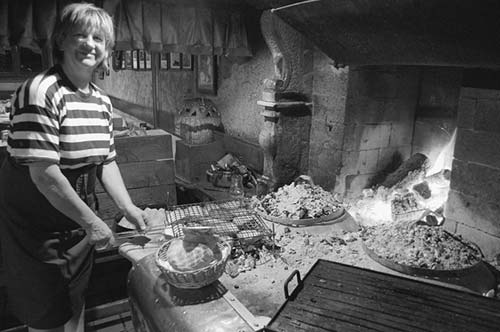
Konoba Astarea, a restaurant down the street and around the corner (on the main road toward Buje), is a local favorite for traditional, take-your-time Istrian cuisine with a focus on fish and lamb. While this isn’t gourmet cooking and truffles are an afterthought, it’s rustic food done very, very well. Anton and Alma Kernjus cultivate a convivial atmosphere; compared with some of the region’s stuffy eateries, this feels like a well-worn neighborhood hangout. Anton ignores the long menu; he’d rather pull up a chair to explain your options. This is a good place to try black risotto (with squid ink). Choose between the warmly cluttered, borderline-kitschy dining room huddled around the blazing open fire, where Alma does a lot of the cooking; the cool and welcoming terrace with faraway sea views; or the relaxing back garden. It’s smart to reserve ahead (figure 200-300 kn per person for a full-blown multicourse meal, or order à la carte: 45-80-kn pastas, 60-180-kn main courses, daily 11:00-23:00, closed Nov, tel. 052/774-384).
• From Brtonigla, simply follow signs into...
Close to the Slovenian border, Buje (BOO-yeh, Buie in Italian) is big and striking from afar, but pretty functional up close. Still, it’s worth a visit if you’re passing through and curious to take a stroll through a hill town that feels more alive and workaday than the norm. Just above the parking lot are the small TI and the town museum (facing each other across the street), and higher up is another parking-lot plaza in front of Buje’s pastel-yellow Church of Our Mother of Mercy (marked in Latin, Mater Misericordiae); from the nearby terrace, you have (distant) views of the sea. From this square, you can hike on cobbles through workaday neighborhoods. Up and to the left you’ll find the squat remains of a mid-15th-century octagonal defensive tower, the small Sv. Martin church with its evocative graveyard, and a viewpoint overlooking the countryside (though views from Motovun and other towns are better). Up and to the right from the main square is the main Sv. Servol church, whose big bell tower—visible from miles around—dominates the hilltop. With a rough, unfinished facade, the church shares a fine little piazza with the local elementary school.

Sleeping and Eating near Buje: In Volpia, a nondescript village five minutes outside of Buje (toward Slovenia), you’ll find a charming stone country house offering reasonably priced rooms and good food. $$ La Parenzana, named for the long-extinct and lamented Istrian rail line, is well-run by Guido Schwengersbauer. He rents 16 woody, simple-but-comfortable, Germanic-feeling rooms (Sb-€39, Db-€78, includes breakfast, no air-con, free Wi-Fi, rental bikes, Volpia 3, tel. 052/777-460,www.parenzana.com.hr, info@parenzana.com.hr) and also runs a restaurant serving up truffle specialties and other dishes cooked over an open fire (60-110-kn pastas, 60-190-kn main dishes, daily 12:00-23:00). The former route of the Parenzana rail line—now a handy hiking and biking trail—runs just behind the property, and Guido runs a sweet little mini-museum about that nostalgic train trip. To get here from Buje, leave town following signs for Trieste and Koper, then turn off toward Plovanija, Portorož, and the Slovenian border; after a couple of minutes, watch for Casa Parenzana signs to the right.
• If you’re interested in a wine-tasting detour to two of Istria’s swankiest wineries (Kabola and Kozlović, both described on here), now’s your chance: Head past the entrance to Buje on the main road past the Grožnjan turnoff, then watch for signs on the right to Momjan/Momiano. Take this road through the village of Kremenje; soon after, you’ll pass Kabola on the right. Kozlović is across the valley around the far side of Momjan.
To skip the wines and continue on our route, leaving Buje, look for signs that take you along a twisty, narrow road (via Triban) right to Grožnjan.
Grožnjan (grohzh-NYAHN, Grisignana in Italian) is your trapped-in-a-time-warp Istrian hill town. Its setting, artfully balanced on the tip of a vine-and-olive-tree-covered promontory, is pleasing, if not thrilling. The time-passed character of its sleepy lanes invites you to get lost and leave your itinerary on your dashboard. Not long ago, Grožnjan was virtually forgotten. But now several artists have taken up residence here, keeping it Old World but with a spiffed-up, bohemian ambience. If gallery-browsing is your idea of fun, you’ll like this place.
Grožnjan has virtually no “sights,” but it’s a delightful place to go for a stroll. All roads lead to the convenient and free parking lot, a few steps from the traffic-free village. Distant sea views from the main terrace at the entrance to town (with a modern café) remind you that you’re not that far from the Adriatic. A few English panels are posted around town, identifying what passes for “important” buildings in this sleepy burg. The town church’s bell tower is its only landmark. Inside the church, the big wall painting over the altar shows angels intervening in the Pula amphitheater to save Christians who were thrown to the lions and tigers.

To get the lay of the land, take a 10-minute town wander: Facing the church’s front door, go left and loop clockwise through town (you’ll pass the town’s lone ATM on your right as you start down the street). Walking along the main street, ulica Umberta Gorjana, you’ll pass the Enoteka Zigante truffle shop (one of many outposts of the truffle magnate described on here), then the TI (which doesn’t have a lot to do; closed Mon, Gorjan 12, tel. 052/776-131, www.tz-groznjan.hr). Then you’ll reach the shaded square with Café Pintur and the Bastia restaurant, then the Italian Cultural Center. Don’t worry about addresses or finding a particular place; whether you want to or not, you’ll find yourself walking in circles, and quickly see what there is to see. Instead, let your pulse slow and enjoy being a castaway on this isolated, tranquil hilltop.
Sleeping and Eating in Grožnjan: $ Café Pintur, a non-descript restaurant on a cozy Grožnjan square just downhill from the church, rents four tiny and basic but comfy top-floor rooms. The Černeka family doesn’t speak much English, but the rooms are cheap and work in a pinch (Sb-€25, Db-€50, includes breakfast Sept-May, or €5 extra June-Aug; cash only, lots of stairs with no elevator, air-con, free Wi-Fi, Mate Gorjana 9, mobile 098-586-188, tel. 052/776-397, ivan.cerneka@pu.t-com.hr).
Café Pintur’s restaurant, open long hours daily in summer, serves up basic pasta and grilled meats (40-50-kn pastas, 40-90-kn main dishes).
Bastia, across the square and sharing a leafy terrace with Pintur, is a bit bigger, with a menu focusing on truffles (50-110-kn pastas, 70-150-kn main dishes, daily 8:00-23:00, 1 Svibnja 1, tel. 052/776-370).
For a scenic picnic, shop at the grocery store facing the church; nearby is a fine shady terrace with benches.
• From Grožnjan, follow signs for Oprtalj. Along the way, you’ll see Završje signs directing you to the right.
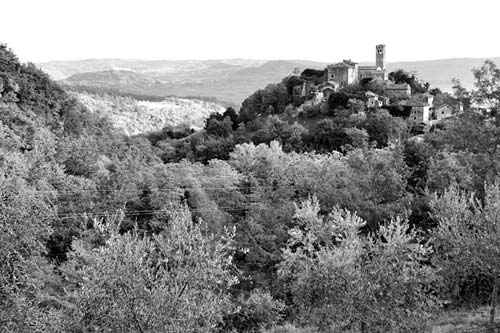
If you’ve ever wanted to visit a nearly deserted hill town, Završje (ZAH-vur-shyeh) is your place. Called “Piemonte d’Istria” in Italiano, this mini-Motovun seems to have more truffle-hunting dogs than people. One of the smallest, most compact, and most picturesquely set hill towns in the area, Završje was once just a double-walled fortress clinging to the top of its bulbous hill. Over time it sprawled just a bit outside its original walls, but it was deserted after the post-WWII Italian exodus and remains almost uninhabited today; only a few locals live here, and virtually all of the buildings are abandoned skeletons. There’s very little to actually “see” or “do” here—no museums, no restaurants, and a sporadically open church with a leaning tower and a colorfully painted Baroque altar. But the EU has taken notice of this precious little burg, and has invested in restoring its pretty pink schoolhouse (at the base of the hill, near the parking lot) and posting informative English descriptions along the street through town. Walk up through the village on this cobbled lane, peering into ruined stone houses and pondering their potential. Thanks to its priceless setting, convenient location a short drive from Motovun, and inherent charm, Završje won’t be overlooked for long. If I were an entrepreneurial Istrian restaurateur, I’d set up a fancy truffle restaurant here posthaste. A stroll through here today will have a big payoff a decade from now, after little Završje has been rediscovered and repopulated with artists, hotels, and restaurants—as it surely will. You’ll be able to say, “Yeah, I was there back when it was a ghost town.”
• If you want to head directly to Motovun, you can simply proceed on the road past Završje and twist down into the valley. Or, for a more scenic approach, backtrack the way you came for a couple of minutes, turning right to follow signs to Oprtalj.
Oprtalj (oh-per-TAL; Porotole in Italian) has a particularly scenic approach, along a twisting driveway lined with pointy cypress trees. But once in the town itself, you’ll find that there’s not much to see. Oprtalj lines up along a plateau with a busy road ripping through its middle. Like Motovun, it has a pink loggia across from its main gate, containing an old stone-carved winged lion of St. Mark and other stony fragments from the town’s history. If you poke up through the gate and wander the town, you’ll find a fairly nondescript, largely deserted burg. Near the gate is the town’s konoba, with seating under a tree out on the view terrace across the street. The fancy yellow building at the Motovun end of town is the elementary school, named for local hero Milan Šorgo, a Partisan who was killed during the fighting to retake his native Istria from the Nazis.
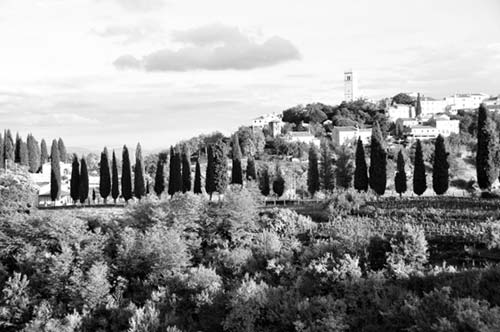
• The road through Oprtalj leads directly down into Livade, then across the valley highway to Motovun.
The flat little crossroads village of Livade, sitting in the valley facing the back of Motovun’s hill, is home to the first and last name in Istrian truffles. In 1999, Giancarlo Zigante unearthed the biggest white truffle the world had ever seen—2.9 pounds, as verified by The Guinness Book of World Records. (In 2007, the record was broken by a 3.3-pound Tuscan truffle.) Zigante’s hunk of fungus—now revered as though it was a religious relic—kicked off a truffle craze that continues in Istria today (see sidebar on here). Today Zigante has a virtual monopoly on Istria’s truffle industry, producing a wide range of truffle goodies. If you’re a connoisseur, or just curious, make a pilgrimage to this truffle mecca. The valley is enlivened by Livade’s White Truffle Days, which take place on weekends from late September through early November; white tents are filled with local producers showing off their truffles, wines, olive oils, and more. While here, you can also drop into Livade’s little museum about La Parenzana, the railway that once linked these hill towns.
Eating in Livade: Zigante’s large facility here is divided into two parts: The Zigante Tartufi shop offers shelves upon shelves of both fresh and packaged truffle products (plus local wines, olive oils, brandies, and more). There’s also a little tasting table where you can sample the earthy goods, and a brain-sized replica of that famously massive chunk of white truffle. A small jar of preserved truffles will run you 85-270 kn, depending on the size, type of truffle, and preparation. You can even pick up a recipe sheet telling you what to do with the precious stuff once you get it home (daily 9:00-21:00, off-season 10:00-20:00, Livade 7, tel. 052/664-030, www.zigantetartufi.com). The adjacent Restaurant Zigante, one of Istria’s fanciest (and most expensive), dishes up all manner of truffle specialties. The decor—inside or out on the terrace—is white-tablecloth classy, the service is deliberate but friendly, and the truffles, as if on a cooking game show, are prepared in a dizzying variety of ways. If you want the full dose of this local delicacy from a place that knows its truffles, this is a worthwhile splurge (85-160-kn starters, 190-300-kn main dishes, 400-600-kn fixed-price meals—even more during white truffle season, daily 12:00-23:00, until 22:00 in winter, Livade 7, tel. 052/664-302).
Eating near Livade, in Gradinje: A five-minute drive east of Livade, in the hamlet of Gradinje, is a rustic, unpretentious eatery serving up the most affordable truffle dishes around. Konoba Dolina (“Valley Inn”) has a nondescript interior and a pleasant terrace out front. Because it’s just beyond the tourist trail, the prices are reasonable and the ambience is more authentic (45-95-kn meals, truffle splurges up to 120 kn, Wed-Mon 12:00-22:00, closed Tue, tel. 052/664-091). First make your way to Gradinje (go into Livade and turn right at the main roundabout, then drive through the countryside for a few minutes). Once in Gradinje, go all the way through town, then look for signs on the left.
• Motovun hovers on the hill just across the valley from Livade (described earlier in this chapter).
Once you’ve seen this area, if you have more time and interest, you can carry on another 40 minutes to reach Hum (follow the main valley road east to Buzet, then to Roč, then look for the turn-off on the right to Hum, along the Glagolitic Lane). Most people won’t find the Hum detour worth the miles, but it works great if you’re headed east anyway (such as to Opatija or Rijeka).
According to its marketing plan, Hum (pronounced “hoom,” Colmo in Italian) is the “smallest town in the world.” While there are surely hamlets even tinier than this, with its population of 16 people, as of a few decades ago—when first it laid claim to this honor—Hum had a Town Hall, church, school, post office, and all the other trappings of a “town”...so it wins the title on a technicality. Smart gimmick.
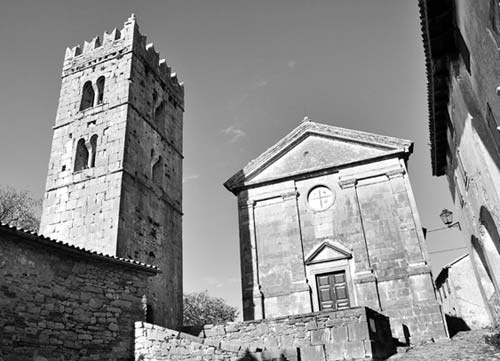
Unfortunately, these days Hum is also, per capita, the most touristy town in the world—crammed with visitors who come to stroll through its streets, drop some kunas in its souvenir shops, or dine at its lone restaurant, Humska Konoba, with fine outdoor terrace seating (daily mid-May-mid-Oct 11:00-22:00, closed Mon mid-March-mid-May and mid-Oct-mid-Nov, Sat-Sun only in winter, tel. 052/660-005).
But despite its quirks and its one-trick commercialism, Hum is engaging. At the far corner of Istria—just up the road from Mount Učka, which forms the natural boundary with the neighboring Kvarner Gulf—Hum feels incredibly remote, rugged, and (if you don’t run into any tour buses) forgotten by modern times.
You’ll enter Hum through its main gate, formed by part of its 11th-century castle. Once inside the characteristic Old Town, you’ll find cobbled lanes connecting the stone houses and 19th-century town church (with five altars). It’s more rustic-feeling than many other villages, with rougher paving stones, more overgrowth, and an even more pronounced yesteryear quality. And yet, you’ll still spot several sobe signs and souvenir shops. Popular mementos—sold at the restaurant and the shops—are little ceramic tiles with your initials using the Glagolitic alphabet (see below).
Getting There: Coming from Motovun on the road following the Mirna River, you’ll pass through Buzet, following signs for Lupoglav and Rijeka. The turn-off for Hum (and the Glagolitic Lane, described next) is on the right, near the village of Roč. (If you’re coming from the highway, get off at the Lupoglav exit, turn toward Ročko Polje, then continue through that village—ignoring the turn-off for Hum—until you reach Roč, with a better route to Hum.) When you’re finished in Hum, you’re not far from the A8 highway back to the south (the coast) or onward to the east (Rijeka or Opatija via the Učka Tunnel).
Nearby: The road between Hum and the Mirna Valley is dubbed the Glagolitic Lane (Aleja Glagoljaša), and commemorates a ninth-century alphabet once used for written Croatian. While the alphabet hasn’t been widely used for centuries, Croatians recognize it as an integral and unique part of their cultural heritage. And in the area around Hum, they’ve clung to the dinosaur alphabet even more than in other parts of the country—claiming it was commonly used here into the 20th century. Today, the alphabet is even taught in some schools, and children have poetry contests and spelling bees in Glagolitic. Along the Glagolitic Lane to Hum, you’ll see various monuments to this alphabet, including giant Glagolitic characters standing in a field, as well as a sort of “Rosetta Stone” on top of a hill comparing the Glagolitic, Cyrillic, and (our) Roman alphabet.
• From Hum, you’re very close to the northeast branch of the ipsilon highway (A-8). You can take this either west to Rovinj (via Pazin), or east to the Učka Tunnel, Opatija, and Rijeka.
The towering Mount Učka separates Istria from the rest of Croatia. And just on the other side of that mountain are a pair of former Habsburg towns that offer a dose of variety (and a convenient pit stop on the way to other Croatian towns): Shot through with the faded elegance of an upper-crust history, Opatija is a welcome change of pace from the salty Venetian-flavored towns along the rest of the Croatian coast. Its elegant Viennese-style cafés delight coffee-sippers, its parks tickle gardeners, and its beaches lure sunbathers. Nearby, the big industrial port city of Rijeka is an important transit hub; if you wind up changing buses or boats here, consider a quick stroll through its run-down but gentrifying urban core.
Opatija (oh-PAH-tee-yah) is not your typical Croatian beach town. In the late 19th-century golden age of the Austro-Hungarian Empire, this unassuming village near the port of Rijeka was transformed into the Eastern Riviera, one of the swankiest resorts on the Mediterranean. While the French, British, and German aristocracy sunbathed on France’s Côte d’Azur, the wealthy elite from the eastern half of Europe—the Habsburg Empire, Scandinavia, and Russia—partied in Opatija. Baroque, Neoclassical, and Art Nouveau villas popped up along its coastline as it became the sunny playground for barons, dukes, and other aristocrats.
Though the Habsburgs are long gone, Opatija retains the trappings of its genteel past. Most of Croatia evokes the time-passed Mediterranean, but Opatija whispers “belle époque.” It may be the classiest resort town in Croatia, with more taste and less fixation on postcards and seashells. Most people don’t come to Croatia for this chic scene. But if rustic seaside villages are wearing on you, cosmopolitan Opatija—which hosts equal numbers of tourists and convention-going businesspeople—is a pleasant return to high-class civilization.

The town is also strikingly situated: tucked beneath thickly forested mountains, looking out to offshore islands, and with a view across the bay of Rijeka’s sprawl. Thanks to its sheltered location nestled under high mountain peaks, Opatija is protected from the Bora wind, enjoying instead a light, refreshing breeze from Učka Mountain. This gives Opatija a particularly mild and enjoyable climate—the perfect match for its refined ambience.
Opatija is basically a one-street town: Ulica Maršala Tita, lined on both sides by stately hotels, follows the seafront. The town’s focal point is its beach area, called Slatina. You can walk from one end of the tourist zone to the other in about 20 minutes. (For a handy loop, walk along the bustling main street in one direction, then back along the waterfront promenade—or vice versa.) Look for a free Wi-Fi hotspot around Slatina.
Opatija’s helpful TI is just a short walk up ulica Maršala Tita from Slatina. Pick up the map, information booklet, and list of hotels (mid-July-Aug daily 8:00-22:00, progressively shorter hours off-season until Nov-Easter Mon-Sat 8:00-17:00, closed Sun; from Slatina, just head a block toward Rijeka and look on the left/non-sea side of road, Maršala Tita 128; tel. 051/271-310, www.opatija-tourism.hr).
Driving in from either Istria or Rijeka, just follow Opatija and bull’s-eye signs and switchback down, down, down to the water. There’s a parking lot at Slatina (the bus-station zone above the main beach), another one behind Hotel Imperial, and ample street parking; all of it costs the same (10 kn/hour).
Begin at Opatija’s centerpiece, the waterfront beach-and-park area called Slatina, with sweeping sea views, a marbled Croatian “Walk of Fame” (with one or two names you might recognize), and a seawater swimming pool. From here, Opatija lines up along its main drag, ulica Maršala Tita, still fronted by ornate villas that would seem more at home in Vienna than they do in Croatia. Austrians and other tourists stroll here hand-in-hand, taking in the views, dipping into high-class boutiques, and snapping photos of the fancy facades as they go. Joining them, you, too, may soon find yourself thinking of this place as the “Monte Carlo of Croatia.”
A few steps toward the sea, stretching in either direction along the waterfront, is a scenic promenade called the Lungomare. This is another wonderful spot for rocky seafront strolling, and it offers striking views across the bay to Rijeka (which looks much better from afar). Near the Slatina end of the Lungomare is one of Opatija’s trademarks: a statue of a woman surrounded by seagulls, called Greetings to the Sea. Much as I’d like to relay some romantic legend behind this evocative monument, the truth is that there’s no story behind it—like Opatija itself, it’s just pretty to look at. Farther along, you’ll pass the Juraj Šporer Artistic Pavilion, which generally hosts free art installations.
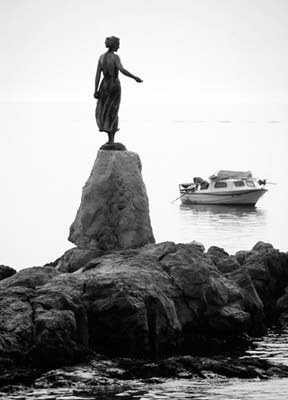
As for sightseeing...well, Opatija is not that kind of place. If you like, you can drop into the opatija (abbey) that gave the town its name, the Abbey of St. James (Opatija Sv. Jakov, right along the Lungomare below the TI). On the dome above the altar is a strangely eerie relief showing St. James standing in a boat, cradling this church in his arm, accompanied by his trademark gourd-on-a-stick, and flanked by palm trees.
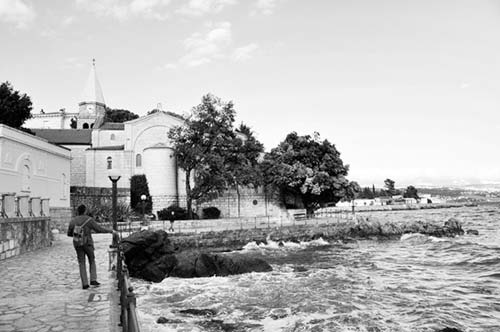
Beyond the abbey, the Lungomare cuts through one of Opatija’s many manicured parks—the large Angiolina Park—and hits the harbor. Near where you enter the park, look for Villa Angiolina, a recently restored mansion with a gorgeous lobby (free to view) and intriguing exhibits upstairs about the history of tourism in Croatia (10 kn, daily June-Sept 10:00-22:00, Oct-May 10:00-18:00). Just uphill through the same garden is Swiss House, with a permanent exhibit about the history of Opatija as a tourist destination (same ticket and hours as Villa Angiolina). Downhill (toward the water) from both of these, you’ll find an outdoor theater that shows movies or concerts nightly in peak season (weather permitting; check with TI for schedule).
Opatija is chock-a-block full of swanky resort-slash-business hotels. While prices are high, you get a lot of luxury for your money (unlike hotels in most small coastal villages). The busiest—and most expensive—times are August (tourists) and September through late October (conventions). Sleeping in Opatija is definitely preferable to overnighting in Rijeka.
$$$ Big and Fancy: These two chain hotels are my favorites of the many opulent Opatija hotels. They have the most striking Habsburg facades in town, and both have luxurious rooms (air-con, elevator, non-smoking rooms, free Wi-Fi, and all the amenities). Each can also refer you to other, similar chain properties (price range depends on season—top price is for Aug). Hotel Bristol, part of the Vienna International chain, has 78 rooms. It’s gone to great pains to maintain its late 19th-century decor inside and out—mixing modern comfort with period moldings, chandeliers, and a cheery yellow facade (Sb-€122/€100/€85, Db-€163/€133/€113, bigger “deluxe” rooms for €10 more, last-minute deals possible, pay guest computer, free Wi-Fi, gorgeously restored coffee shop in lobby, parking-€10, Maršala Tita 108, tel. 051/706-300, www.hotel-bristol.hr, info@hotel-bristol.hr). Hotel Agava, part of the Milenij chain, also has an impressively restored old shell, but its 76 rooms feel more businesslike and contemporary (Sb-€100/€90/€80, Db-€165/€145/€120, sea view-€10 extra; cheaper “economy” rooms are in the attic, with small skylight windows—about 15 percent less; hotel dinner-€6 extra/person, free Wi-Fi in lobby, free cable Internet in rooms, parking garage-€13, Maršala Tita 89, tel. 051/278-200, www.milenijhoteli.hr, info@milenijhoteli.hr).
$$$ Smaller and Family-Run: These two small hotels, run by the Brko family, are well-located a few steps from the lively Slatina scene (to the right as you face the water; both have air-con, elevators, free Wi-Fi, and a parking garage for €11). Hotel Galeb, with 25 comfortable rooms and three stars, has more character than most Opatija hotels, but is a tad overpriced. Guests at the Galeb have access to the pool and beach at the Savoy, described next (Sb-€100/€79/€71, Db-€136/€106/€95, €10 more for “superior” room with sea view and balcony, 10 percent less if you pay cash, pricier suites also available, Maršala Tita 160, tel. 051/271-177, www.hotel-galeb.hr, info@hotel-galeb.hr). Hotel Savoy, across the street, comes with four stars, more class, 32 nicely appointed rooms, an enticing swimming pool with a great view, a private beach, and higher prices. Request the type of room you want when you reserve: Most rooms have balconies and sea views for no extra charge, but many of these face a noisy nightclub; for more quiet, you can request a back (non-view) room facing the street (rates about 20 percent more expensive than Galeb, Maršala Tita 129, tel. 051/710-500, www.hotel-savoy.hr, info@hotel-savoy.hr).
Many hotels offer a “half-board” option (dinner at the hotel) that can be a good value for a decent, affordable meal. Otherwise, touristy restaurants abound. To browse for your own picnic, drop by the old-fashioned indoor market hall (tržnica, on the left a 10-minute walk up Maršala Tita from Slatina). Several hotel lobbies also have refined Vienna-style coffee houses with late 19th-century appeal. For a good, unpretentious sit-down meal, consider one of the following options.
Ružmarin, tucked in a residential zone just behind and above a row of big hotels, is a sane oasis with an inviting covered terrace, a modern dining room, and good pizzas, pastas, and other dishes (35-70-kn pizzas, 50-75-kn pastas, 45-130-kn main dishes, daily 10:00-24:00, up the road behind Grand Hotel Palace at Veprinački put 2, tel. 051/712-673).
Roko, along the busy main drag, has a cozy stone-and-brick interior, a small terrace, and a busy wood-fired oven turning out tasty Italian meals. If you find this place calming, it may be because it was the home of Opatija native Leo Henryk Sternbach, who invented Valium (40-80-kn pizzas and pastas, 70-140-kn main dishes, daily 11:00-24:00, Maršala Tita 114, tel. 051/711-500).
Just to the west of Opatija—enveloped in that city’s resort sprawl—is the real-feeling village of Volosko, with a busy fishing harbor surrounded by restaurants and cafés. The best-regarded is Le Mandrać, named for the enclosed, square fishing harbor that it sits on. With a contemporary-styled interior and a partially glassed-in terrace, this splurge restaurant serves up classic Croatian flavors using modern methods (such as sous-vide), upscale presentation, and a touch of French and Asian-fusion flair. As it earns raves for its creative approach to local cooking, reservations are smart in the summer (70-200-kn dishes, various fixed-price meals for 300-500 kn, daily 11:00-24:00, obala F. Supila 10, tel. 051/701-357, www.lemandrac.com). Volosko is adjacent to Opatija, in the direction of Rijeka; you can walk from Opatija to Volosko in about 30 minutes, or drive there in five (you’ll dive along the top of town, then take a hard right to head down to the lower street and look for parking, and finally walk down one more level to the waterfront and harbor).
Intercity buses leave Opatija from the big Slatina square, just above the beach (next to Grand Hotel Palace); before boarding, buy tickets at the Autotrans office just up the steep road out of town.
From Opatija by Bus to: Rijeka (2/hour, 30 minutes), Pula (12-14/day, 2 hours), Rovinj (3/day, 3 hours), Zagreb (7-8/day, 3 hours), Split (3/day in summer, fewer on weekends and off-season, 8 hours), and Dubrovnik (1/night, departs around 22:00, 12 hours). Info: Mobile 060-306-010, www.autobusni-kolodvor.com.
The industrial city of Rijeka (ree-YAY-kah; it translates as “River”) became Croatia’s biggest port under Austro-Hungarian rule. It’s dainty little Opatija’s bigger, burlier brother (with a population of 129,000). Like Opatija, much of Rijeka’s architecture is reminiscent of the glory days of the Habsburgs. But unlike Opatija, most of Rijeka’s buildings haven’t been renovated in the last century or so, giving it a seedy, gritty, past-its-prime feel. Since it’s a major transportation hub, there’s a good chance you’ll pass through. Here are the basics.
The bus station, train station, and ferry terminal are within a few blocks of each other in a bustling waterfront business zone. The sector is crossed by two one-way streets (going in opposite directions): Ivana Zajca (or the “Riva,” along the waterfront, runs west to east) and Adamićeva (which changes its name a few times as it cuts east to west through town).
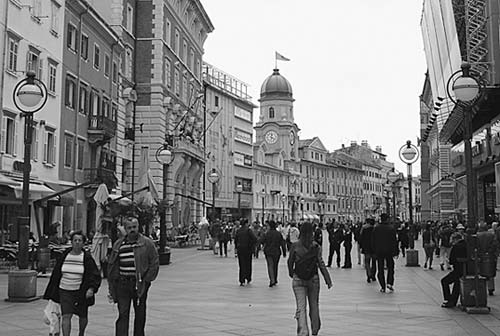
A block above these two streets is the Korzo, an almost-charming pedestrianized zone packed with shops, restaurants, and the TI (mid-June-mid-Sept Mon-Sat 8:00-20:00, Sun 9:00-14:00; mid-Sept-mid-June Mon-Fri 8:00-19:30, Sat 8:00-13:30, closed Sun; Korzo 14, tel. 051/335-882, www.tz-rijeka.hr).
The train station is a few blocks west of the Korzo. On arrival, exit the station to the right and walk 10 minutes to the water. You’ll first come to the bus station, then the ferry terminal. The Korzo is just above them.
The bus station is basically a big parking lot in the middle of the chaos, near the west end of the Korzo. You’ll see the big boats along the waterfront as you exit your bus. To get to the train station, face the water and turn right, following the busy street about 10 minutes.
The ferry terminal is at the east end of the waterfront. The Jadrolinija ticket office is in the building with the big Jadrolinija sign (at Riva 16, second building east of bus station, ticket office at far right end of building as you face it).
Rijeka’s downtown car-rental offices—including Avis (tel. 051/311-135), Hertz (tel. 051/311-098), and Thrifty (tel. 051/325-900)—tend to move from year to year, so be sure to call first to ask for the location. Additional car-rental offices are at the airport.
From Rijeka by Boat to the Dalmatian Coast: The very slow Jadrolinija car ferry plods to Dalmatia twice each week in summer (June-Sept only, departs in the evening and goes overnight to Split, then onward down the coast; figure 11 hours to Split, 18 hours to Korčula, 21 hours to Dubrovnik).
From Rijeka by Train to: Zagreb (3/day direct, 4-5 hours), Ljubljana (2/day direct, 3 hours).
From Rijeka by Bus to: Opatija (2/hour, 30 minutes), Senj (hourly, 1.5 hours), Pula (nearly hourly, 2-2.5 hours), Rovinj (4-5/day, 2-3.5 hours), Zagreb (hourly, 2-3.5 hours), Split (7-10/day including some night buses, 6-8 hours), Dubrovnik (4/day, 12.5-13 hours, includes night buses), Ljubljana (1/day in summer, none off-season, 2.5 hours). For schedules, see www.autotrans.hr or call 051/213-821.
The long stretch of Croatian coast from Istria to Dalmatia—between the cities of Rijeka and Zadar—offers twisty seaside roads, functional port towns and fishing villages, some of the country’s most rugged scenery, and no real knockout sights. South of Opatija and Rijeka, the Kvarner coastline is stark and desolate—most traces of settlement have been long since blown away by the battering Bora wind (see sidebar on here). But offshore, sheltered from the elements, are several islands—Krk, Cres, Lošinj, Rab, and Pag—each with its own character and appeal. Still, Croatia offers more bang for your buck to the north (Istria) and the south (Dalmatia).
If you’re driving between northern Croatia (Zagreb, Plitvice, Istria, or Opatija) and the Dalmatian Coast (Zadar, from where the expressway zips to Split), you have two options: Use the fast inland A-1 expressway, or follow the slow Kvarner Gulf coastal road all the way down.
The A-1 expressway option is boring but faster and far more efficient, especially from Zagreb or Plitvice. If you’re coming from Zagreb, just take A-1 directly to Split; from Plitvice, drive south through Korenica to access A-1 at Gornja Ploča (see here). From Istria or Opatija, you have two options for accessing A-1 that take about the same amount of time: Head east (inland) from Rijeka on A-6 to join A-1; or, more interesting (and better for southern destinations), drive the Kvarner coastal road as far south as Senj, then cut inland and up over the mountains to Otočac, where you can get on A-1.
The two-lane Kvarner coastal road (national road #8, a.k.a. E-65) is twisty and slow, but more scenic. Speedy sightseers won’t find it worth the time. Compared to the expressway, you’ll lose at least an hour if you’re coming from Istria or Opatija, and much more if you’re starting in Zagreb or Plitvice. Along this road, you’ll enjoy good but not spectacular views—similar to what you’ll see in Dalmatia, but less developed. To find this road from Rijeka, just follow signs for Split and Zadar (being careful not to get on the expressway).
It’s striking how desolate it feels as you drive along the Kvarner coastal road. The most appealing spot for a break is Senj (pronounced “sehn”—the j is mostly silent, but has a slight y sound). Senj has a little harbor and a modest square with a jumble of outdoor cafés. The town is watched over by the boxy fortress of a band of pirates called the Uskoks. These were Serb and Croat refugees forced out of their homes in the interior when the Ottomans invaded in the 16th century. After resettling here in Senj, they became pirates and began terrorizing the Adriatic coastline. While they claimed to target only Ottoman ships, they also harassed anyone who traded with the Ottomans—including the Venetians. Finally the Austrians—bowed by political pressure from Venice—put down the Uskoks. Today Senj is the best jolt of civilization along this road, with busloads of tour groups constantly dropping off here for a coffee-and-WC break. This means that the natives of Senj—perhaps harkening back to their pirate ancestors—are adept at overcharging and shortchanging visitors. Check your bill carefully against the posted menu prices.
Senj is also the easiest point where the Kvarner coastal road connects to the speedy A-1 expressway that runs parallel to the coast inland. From Senj, a well-traveled road cuts away from the coast and soon begins twisting up the coastal mountain range. After about an hour, you’ll arrive at the A-1 expressway, followed by the war-scarred town of Otočac. (For more on Otočac, see here.)